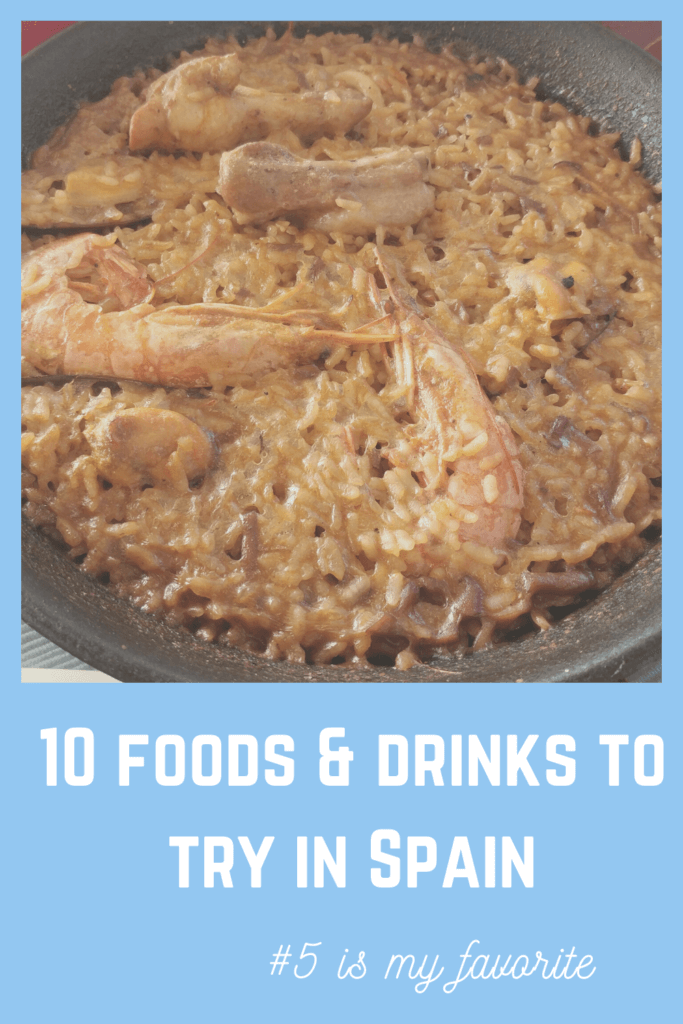10 Foods & Drinks To Try In Spain
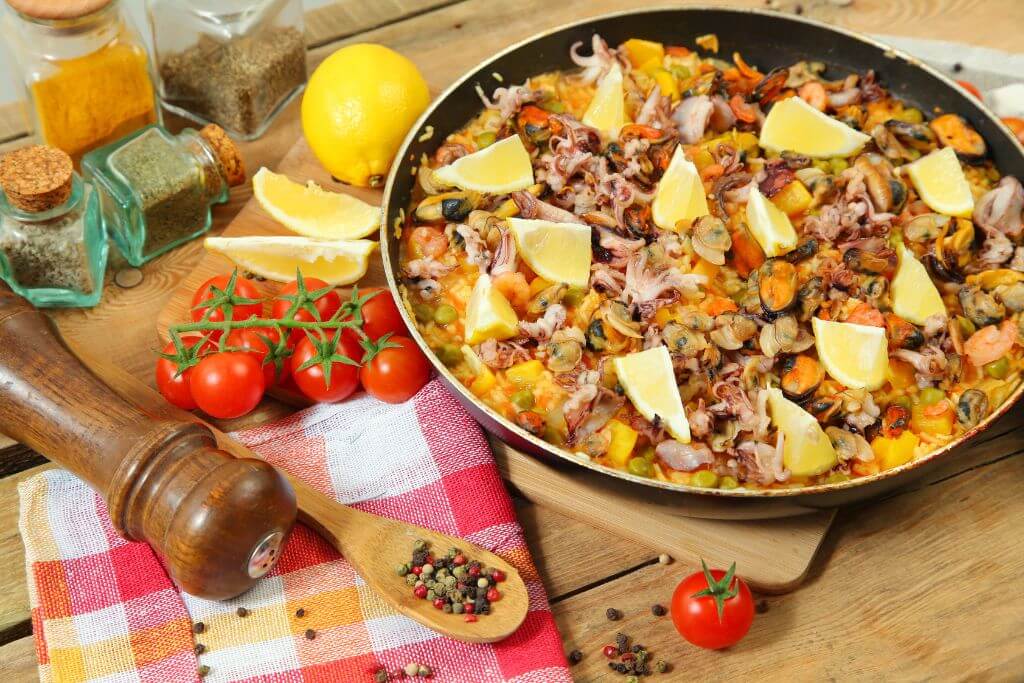
In this blog post, you will find everything you need to know about the top 10 delicious foods & drinks to try in Spain.
Spain is a country renowned for its rich and diverse culinary culture, with a cuisine that is heavily influenced by its geography, history, and culture.
Spanish cuisine includes a lot of cheese, seafood, olives, fresh fruit and veggies, rice, cured meats, potatoes, bread, etc.
Spanish foods and drinks are popular worldwide and are some of the tastiest dishes to try.
What Are Traditional Spanish Foods?
Some traditional Spanish foods include paella (rice dish with saffron and various meats or seafood), gazpacho (cold soup made with vegetables), tortilla de patatas (potato omelet).
Also, pulpo a la gallega (Galician-style octopus), churros (fried dough pastry), and various cured meats such as jamón ibérico and chorizo.
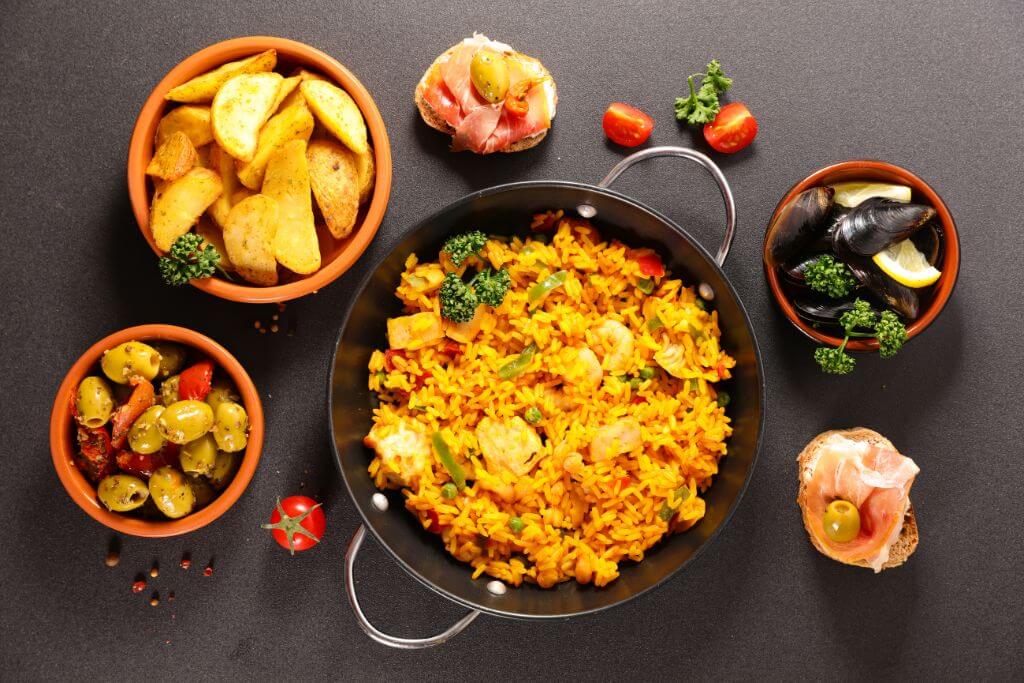
10 Foods & Drinks To Try In Spain
Let’s begin with one of my favorite items on this list – Cava.
1. Cava
Cava is essentially a traditional sparkling wine that is widely popular in Spain.
We tried a few different types and they were all pretty tasty.
Most of them were on the dry side (brut) which was good for me because I like dry wines.
They had some sweet/dessert cava as well but we didn’t try any of them.
You cannot visit Spain without trying at least a glass.
What is a Cava?
Cava is a type of sparkling wine that originates from the Catalonia region of Spain.
It is made using the same traditional method as French Champagne, where a second fermentation takes place in the bottle.
Cava can be made from a variety of grape varieties, including Macabeo, Xarel-lo, and Parellada, and is typically crisp, dry, and refreshing.
It is often used in celebrations and is a popular choice for toasting in Spain.
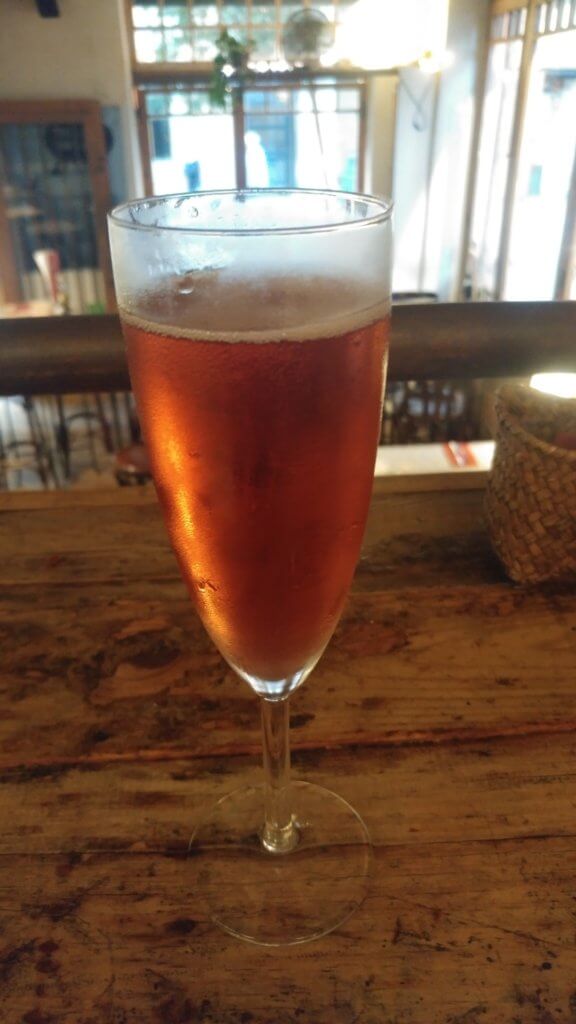
Does Cava have alcohol?
Yes, Cava is an alcoholic beverage and it is one of the foods & drinks to try in Spain.
Like most wines, it contains alcohol, typically ranging from 11.5% to 12.5% alcohol by volume.
However, the alcohol content can vary depending on the specific Cava and the winemaker’s style.
What ingredient is in Cava?
Cava is a type of sparkling wine that is typically made from a blend of three native grape varieties in Spain: Macabeo, Parellada, and Xarel-lo.
Some Cava producers may also add small amounts of sugar, known as dosage, to balance the wine’s acidity and add a touch of sweetness.

What is the difference between Champagne, sparkling wine, and Cava?
Champagne, sparkling wine and Cava are all types of carbonated wines, but they are made in different regions.
Also, they are produced with different grape varieties and production methods, which gives them distinct characteristics.
In terms of taste, Champagne has crisp acidity and complex flavors.
Sparkling wine can vary greatly depending on the grape varieties and region of production.
Cava is typically dry and crisp, with a lighter body and flavors of green apple and citrus.
Why is Spanish Cava so much cheaper than French Champagne?
Spanish Cava is generally less expensive than French Champagne for several reasons.
The cost of producing Cava is generally lower than that of Champagne.
Also, the grape varieties used in Cava production are less expensive than those used in Champagne.
Champagne is required by law to be aged for a minimum of 15 months before release, while Cava is only required to be aged for a minimum of 9 months.
This longer aging process increases the production cost of Champagne, making it more expensive.
Additionally, Champagne is a well-known luxury product that has been marketed and branded as such, which adds to the price.
Cava, on the other hand, is not as widely known and does not have the same branding or marketing as Champagne.

What is the difference between Cava and Prosecco?
Cava and Prosecco are both types of sparkling wines, but they differ in terms of the grapes used in the production, the methods used, and the flavor profiles.
Prosecco is a sparkling wine that is produced in the Veneto region of Italy, using the Glera grape variety.
The production method is the Charmat method, which involves secondary fermentation in stainless steel tanks rather than in the bottle.
Prosecco is generally fruitier and sweeter than Cava, with flavors of peach, pear, and apricot.
Also, Cava tends to have a more complex and nuanced flavor profile, while Prosecco is often lighter and fruitier.
Both are enjoyable as aperitifs or paired with food, and the choice between the two often comes down to personal preference and the occasion.
Is there a lot of sugar in Cava?
The amount of sugar in Cava can vary depending on the specific type of Cava and the winemaker’s style.
The least sweet is Brut Nature or Brut Zero: no added sugar, less than 3 grams of residual sugar per liter.
And the sweetest is Dulce or Sweet: sweet, with more than 50 grams of residual sugar per liter.
If you’re concerned about the amount of sugar in your wine, be sure to check the label for the specific sweetness level.

2. Churros
Churro is a type of elongated pastry that is deep-fried and usually has sugar sprinkled on top.
People commonly consume churros for breakfast with coffee.
I highly recommend eating them while hot and fresh otherwise they become a bit hard.
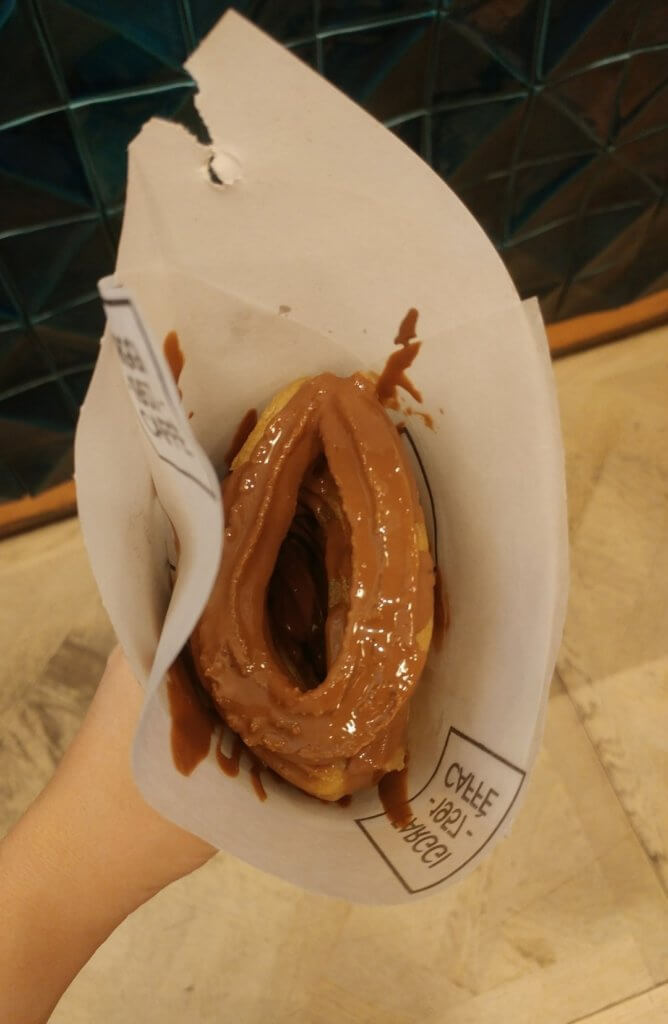
What are Churros?
Churros are a traditional Spanish pastry that people typically eat for breakfast or as a snack.
They are made from a simple dough of flour, water, and salt that is piped through a star-shaped nozzle and fried until crispy.
The resulting pastry is long, thin, and ridged, with a crunchy exterior and a soft, chewy interior.
Churros are often served with a cup of thick hot chocolate for dipping or sprinkled with sugar or cinnamon.
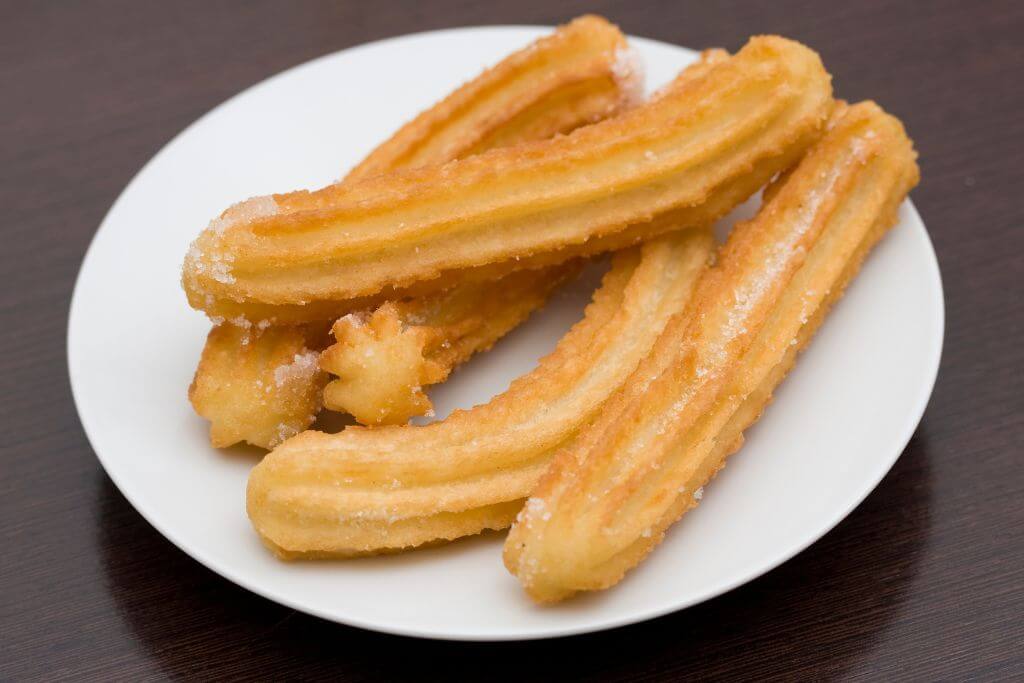
Where did churros come from?
The exact origin of churros is not clear, but they are believed to have originated in Spain or Portugal.
Churros were initially a simple food, eaten by farmers and laborers for breakfast or as a snack.
Over time, they became more popular and were sold by street vendors, eventually becoming a staple of Spanish cuisine.
What are churros made of?
The ingredients for the dough typically include flour, water, and salt, although some recipes may also include eggs, milk, or other flavorings.
Are churros typically filled?
Traditionally, churros are not typically filled, although there are variations on the classic recipe that do include fillings.
Traditional churros are simply long, thin sticks of fried dough that are often dusted with sugar or cinnamon and served with a cup of thick hot chocolate for dipping.
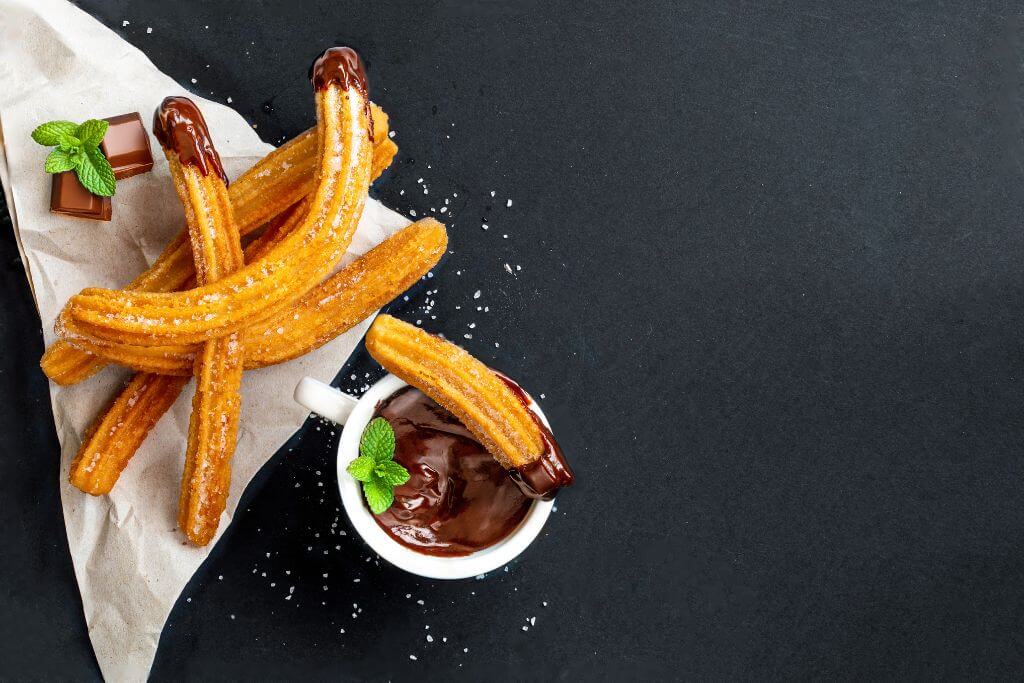
What do you eat churros with?
Churros are traditionally eaten with a cup of thick hot chocolate for dipping.
The hot chocolate is often thick and rich, like a pudding and provides a creamy and indulgent contrast to the crispy texture of the churros.
In addition to hot chocolate, churros can also be served with other dipping sauces or toppings, depending on personal taste.
Also, some people enjoy dipping churros in Nutella, caramel sauce, or fruit preserves.
Do traditional churros have cinnamon?
Traditionally, churros are not made with cinnamon, but they are often dusted with cinnamon and sugar after they are fried.
The cinnamon sugar adds a sweet and slightly spicy flavor to the crispy churros and is a popular way to serve them in Spain.
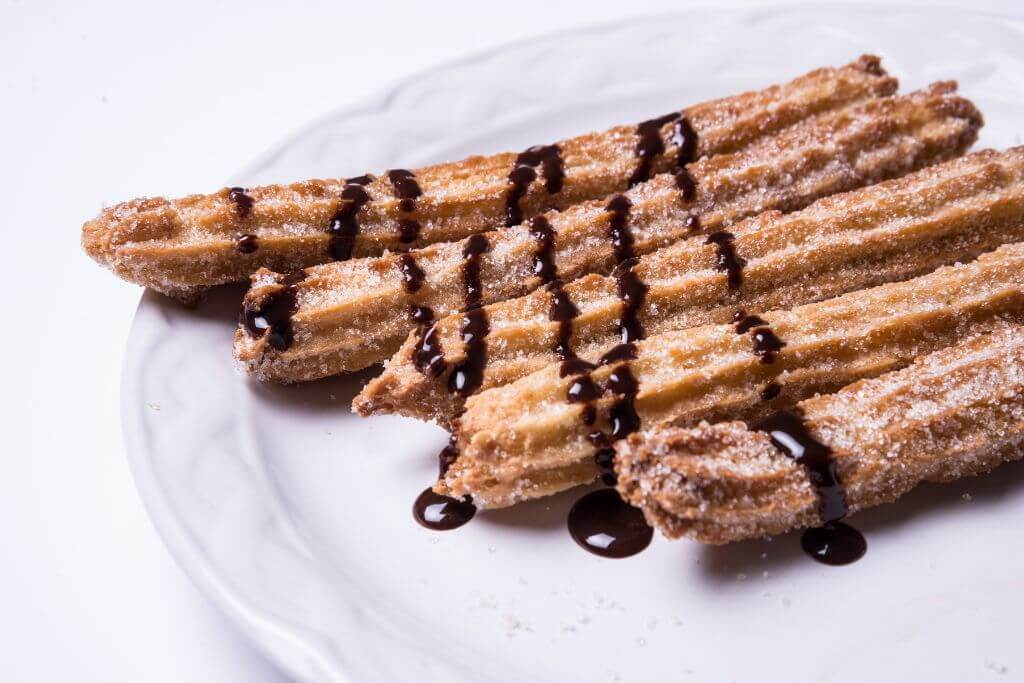
3. Tapas
Tapas are essentially small plates of food or appetizers and are one of the foods & drinks to try in Spain.
The tapas could be either hot (ex. calamari) or cold (ex. olives). Tapas bars are widely popular in Spain.
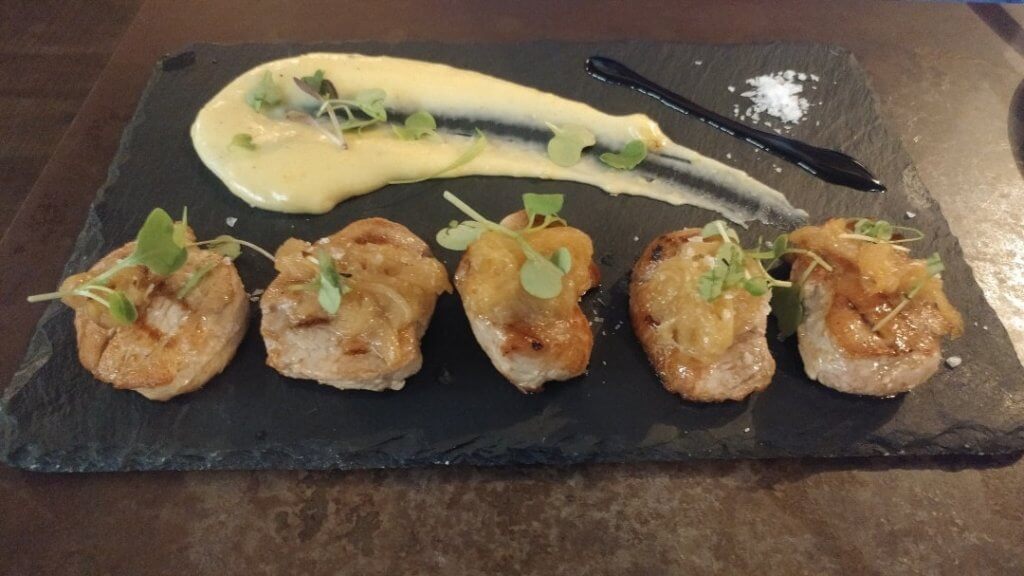
Especially for people who want to try a variety of different dishes, big groups who want to share, or folks who only want to grab a snack.
Also, you can order mixed plates where you can have a little bite of different items.
What are tapas?
Tapas are a variety of small savory dishes or appetizers that originated in Spain.
They are typically served as snacks or as a part of a meal and can include a wide range of ingredients and flavors, such as cheese, olives, cured meats, seafood, and vegetables.
The tradition of serving tapas is often associated with socializing and sharing food with others.
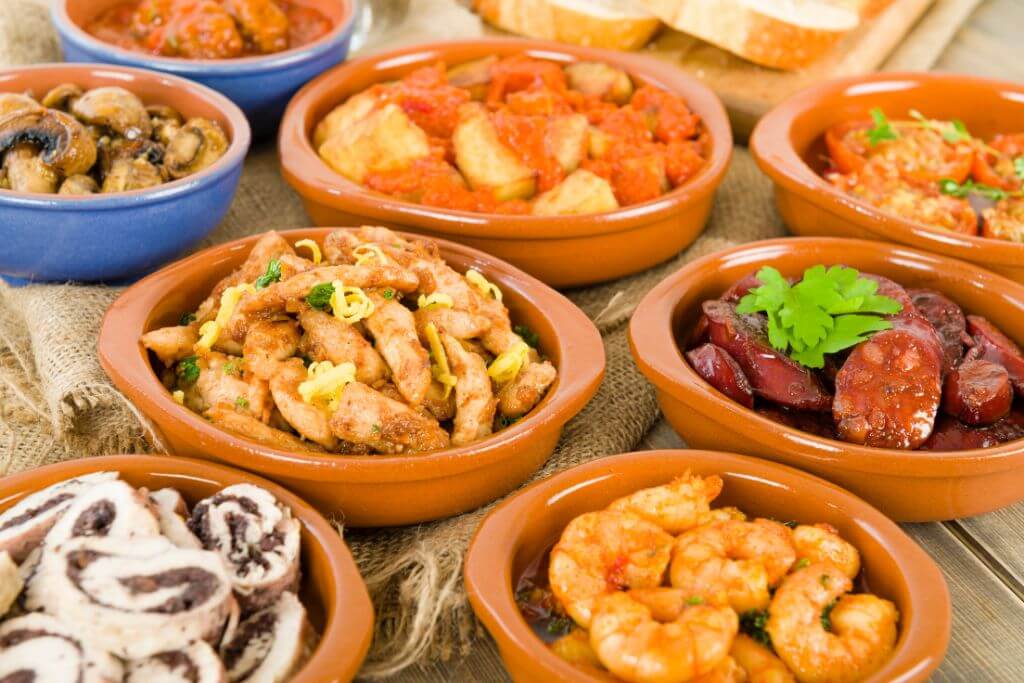
Why are tapas so popular in Spain?
There are several reasons why tapas are so popular in Spain.
One reason is that they are a versatile and tasty way to sample a variety of different flavors and ingredients.
Another reason is that they are often served in a social setting, allowing people to share food and have a conversation with friends and family.
Additionally, the tradition of serving tapas dates back many years in Spain and has become an important part of the country’s culinary culture.
Finally, tapas are often affordable and accessible, making them a popular choice for casual dining and snacking.
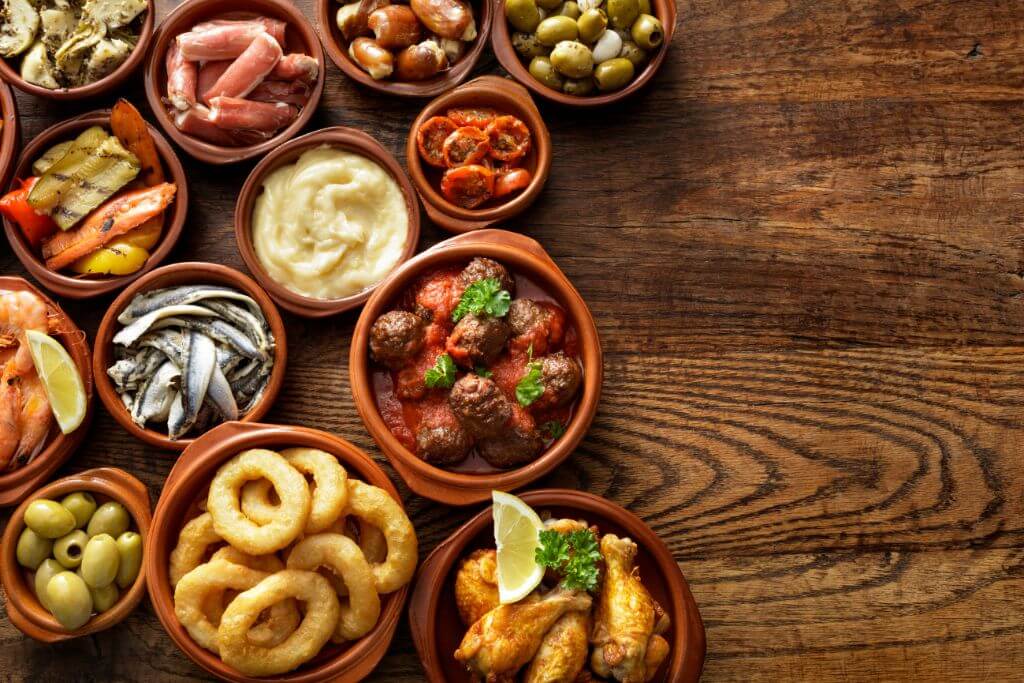
What are the best tapas to order?
There are many different types of tapas to choose from, here are some popular ones:
Patatas bravas – fried potato cubes served with a spicy tomato sauce
Tortilla española – a classic Spanish omelet made with potatoes and onions
Croquetas – small fried balls filled with ham, chicken, or cheese
Gambas al ajillo – shrimp sautéed with garlic and olive oil
Boquerones – marinated anchovy fillets
Albóndigas – meatballs in tomato sauce
Pan con tomate – bread rubbed with garlic and tomato and drizzled with olive oil
Of course, there are many more types of tapas to try, and part of the fun of ordering tapas is experimenting with new flavors and combinations.
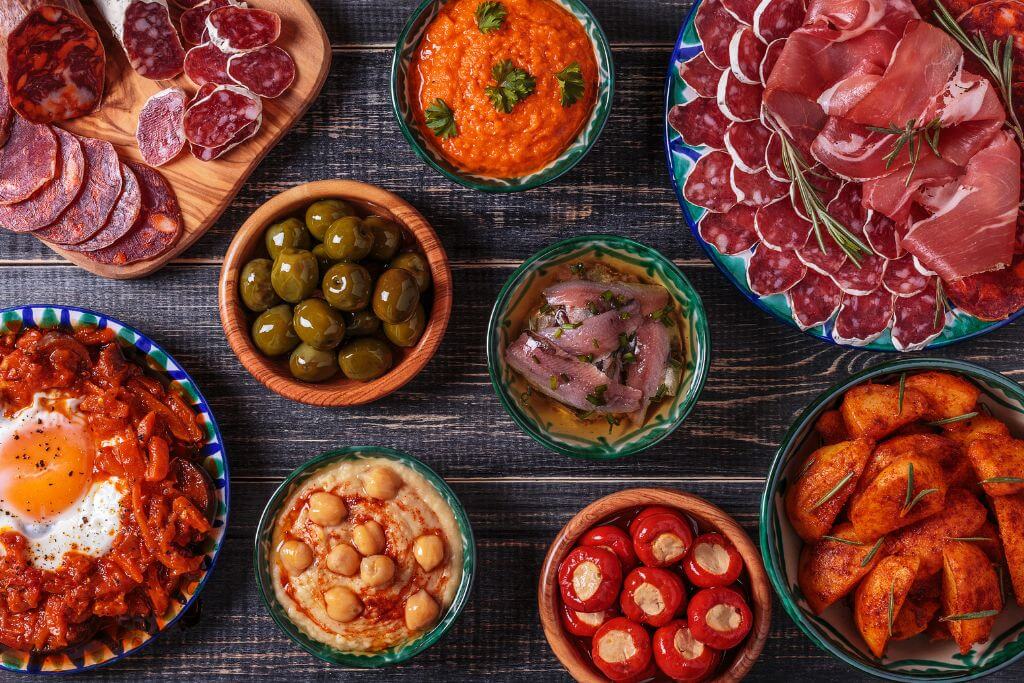
What should I drink with tapas?
Wine – Spanish wines, such as Rioja or Albariño, are a popular choice to enjoy with tapas. Red wine is often paired with stronger, meat-based tapas, while white wine is a good match for seafood and vegetable tapas.
Sangria – Sangria is a traditional Spanish drink that is made with red wine, fruit, and sometimes brandy or liqueur. It is a refreshing and fruity drink that pairs well with many types of tapas, especially during the summer months.
Beer – In Spain, beer is a popular drink to enjoy with tapas. Light and refreshing beers are a good match for most types of tapas.
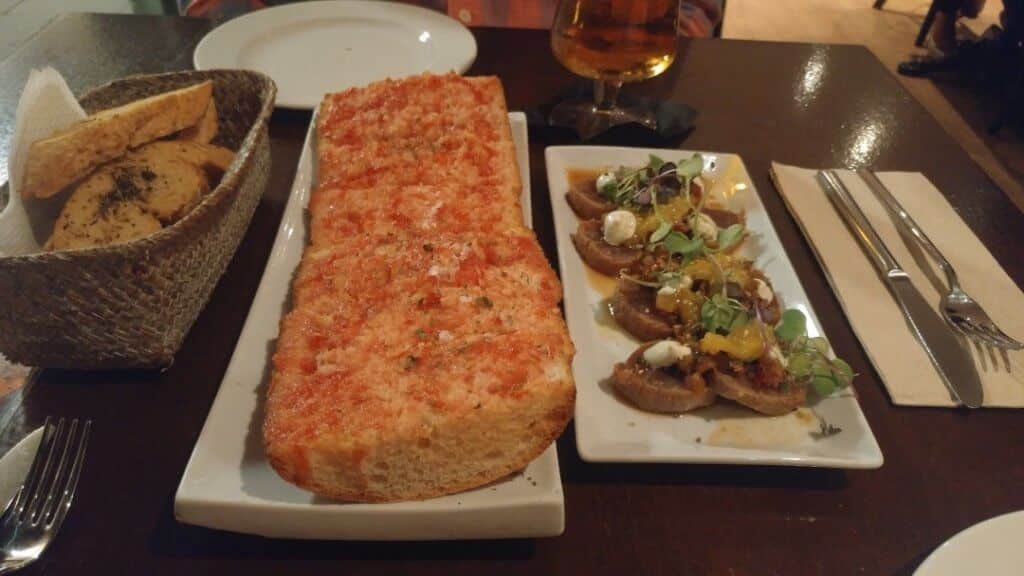
🦄 If you want to learn more about Mallorca, check out this blog post:
A Day Trip Around Mallorca
5 Things You Must See In Palma De Mallorca
4. Paella
Paella is probably one of the best-known traditional Spanish dishes.
It is made with rice and some type of meat, seafood, vegetables, or a combination of them. It is cooked in a shallow pan over an open fire.
I loved the seafood ones (muscles, prawns) and also the ones with chorizo (a bit spicy).
It is usually a full-size meal (not tapas size).
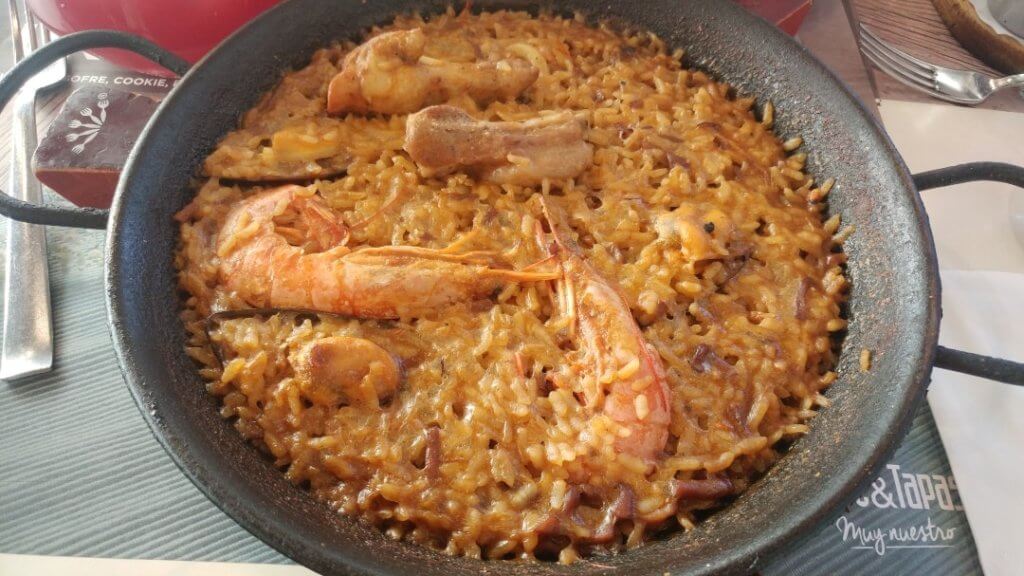
What is Paella?
Paella is a traditional Spanish rice dish that originated in the Valencia region of eastern Spain.
The dish is typically made with short-grain rice, saffron, and a variety of meats or seafood, along with other ingredients like onions, peppers, and tomatoes.
You cook Paella in a large, shallow pan over an open flame, and the result is a flavorful, slightly crispy rice dish.
The most common types of paella include paella valenciana (with chicken and rabbit), paella de marisco (with seafood), and mixed paella (with a combination of meat, seafood, and vegetables).
What does traditional paella have in it?
Traditional paella typically includes a variety of ingredients, which can vary depending on the specific recipe and the region of Spain where it is being made.
However, there are some ingredients that are commonly found in most traditional paella recipes. These include:
Short-grain rice – the base of the dish and provides a creamy texture and nutty flavor
Saffron – gives the dish its signature yellow color and distinct aroma
Sofrito – a mixture of onions, garlic, and tomatoes that becomes the base for the dish
Meat – chicken, rabbit, or pork, or seafood, such as shrimp, mussels, and clams
Vegetables – bell peppers, green beans, and peas
Stock or broth – used to cook the rice and infuse it with flavor
Other common ingredients that could be a part of traditional paella recipes include paprika, garlic, bay leaves, and lemon wedges.
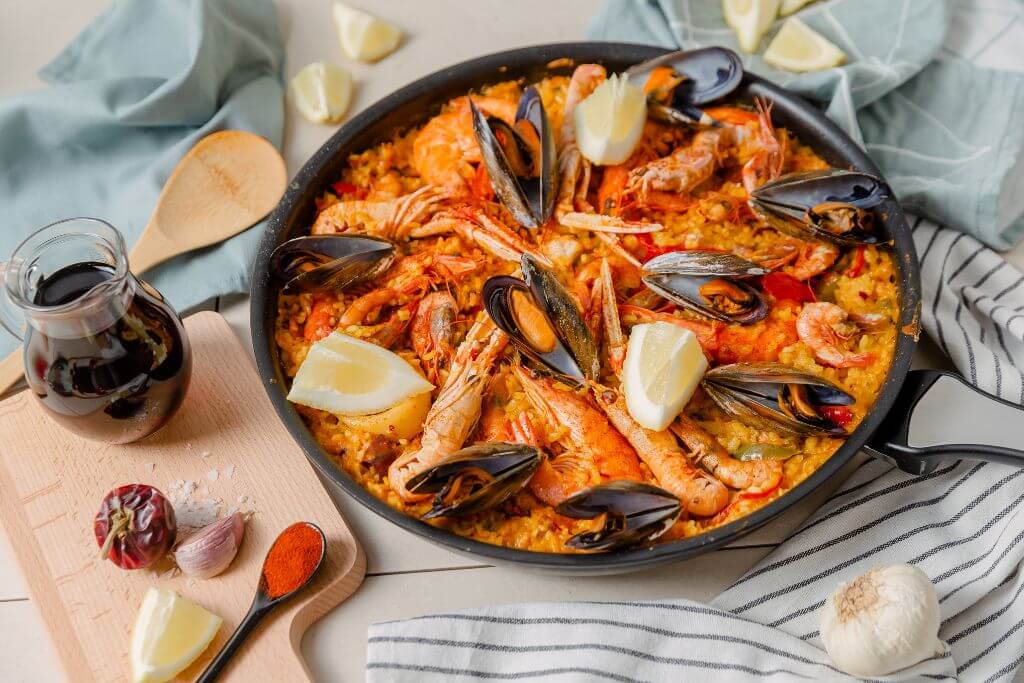
What do you drink paella with?
Sangria – The fruity and refreshing flavors of sangria can be a good complement to the rich and savory flavors of paella.
Red wine – Paella is good with a medium-bodied red wine from Spain, such as Rioja or Tempranillo, which can complement the flavors of the dish.
White wine – A crisp white wine, such as a Spanish Albariño or a French Chablis, can also be a good match for seafood-based paellas.
Beer – A cold beer can be a refreshing choice to enjoy with paella, especially during the warmer months.
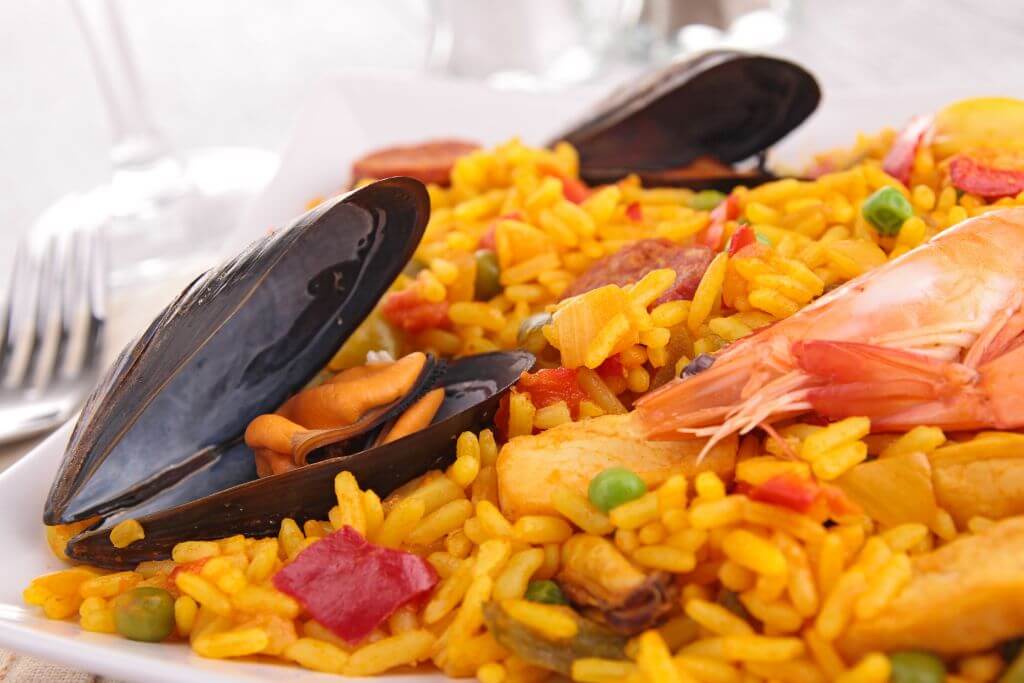
What are the three main types of paella?
The three main types of paella are Valencian paella (paella valenciana), seafood paella (paella de mariscos), and mixed paella (paella mixta).
What meat does paella have?
Paella can include a variety of meats, such as chicken, rabbit, and sometimes duck or pork. Also, some paellas have seafood.
What is the most famous paella?
The most famous type of paella is the Valencian paella (paella valenciana) – the original version of the dish.
It typically includes chicken, rabbit, and sometimes snails, along with vegetables and seasoning, cooked with short-grain rice in a wide, shallow pan.
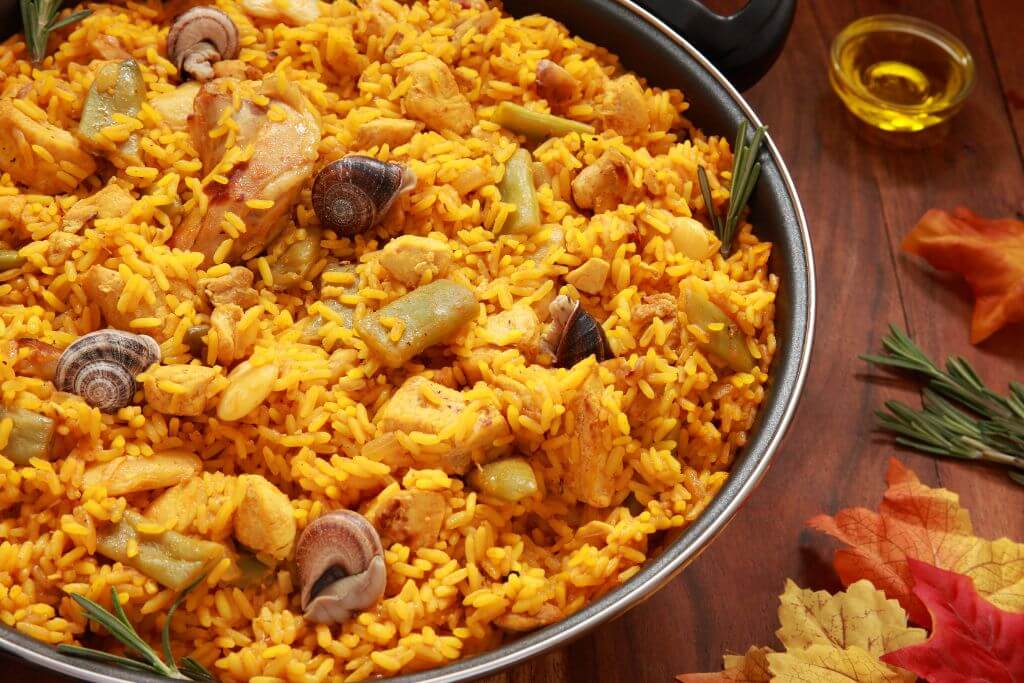
5. Sangria
Sangria is a wine-based punch that has fruit in it, such as oranges, apples, berries, etc.
I recommend the red wine one – soo good and refreshing. They sell them by the glass or in a pitcher.
Combine a nice cold sangria with some tasty tapas (omg, I am drooling).
Perfect for a lunch drink, especially on a hot day. Definitely my favorite!!!
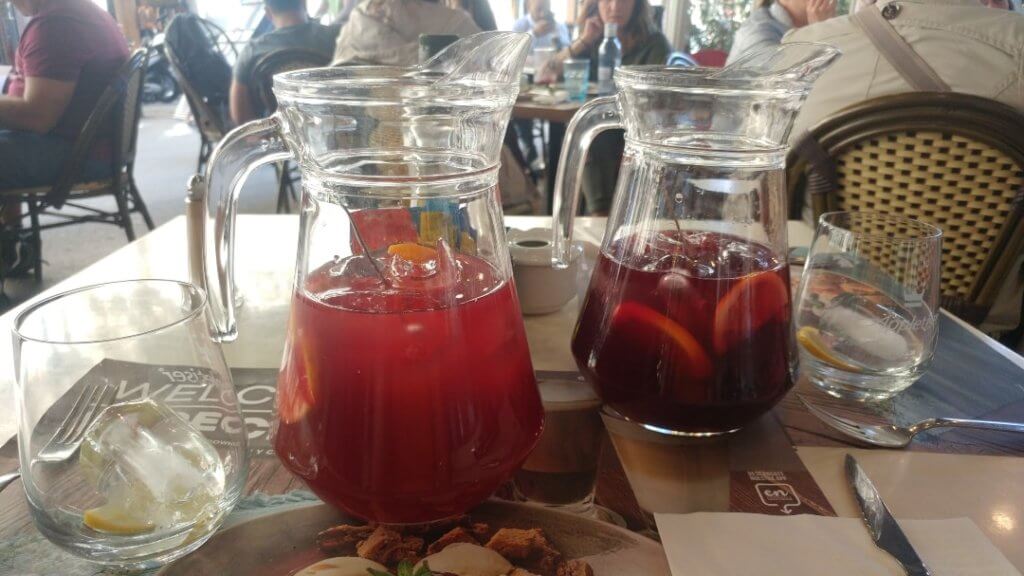
What is sangria?
Sangria is a traditional Spanish drink made by mixing red or white wine with chopped fruit, such as apples, oranges, and lemons.
Sometimes they come with other ingredients such as brandy, orange juice, and soda water.
The mixture is typically served chilled and is a popular beverage during the summer months in Spain and in many other parts of the world.
What fruit should you add to sangria?
Some commonly used fruits for sangria include oranges, lemons, limes, apples, peaches, pineapples, and berries, such as strawberries or raspberries.
Also, you can add to a sangria mango, kiwi, grapes, and melon.
The fruit is typically chopped into small pieces and added to the wine and other ingredients to infuse the sangria with its flavors.
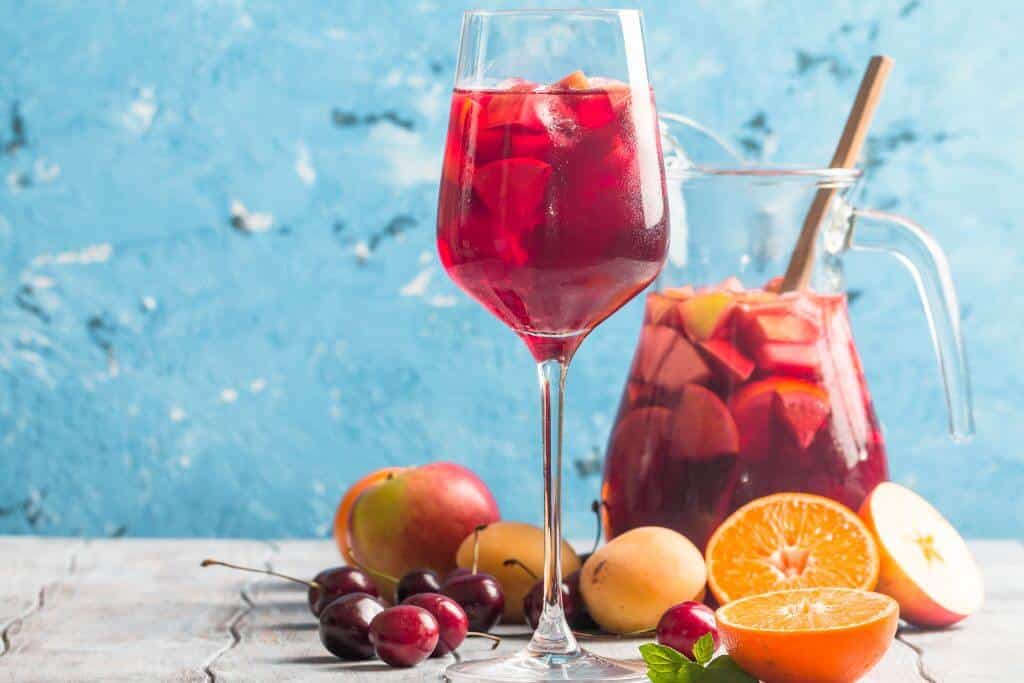
What kind of alcohol is in sangria?
Sangria typically contains red or white wine as its primary alcoholic ingredient.
In addition to the wine, some recipes for sangria may also include other types of alcohol, such as brandy or liquor.
What type of wine is best for sangria?
Traditionally, red wine is used for red sangria, and white wine is used for white sangria.
In general, a dry or semi-dry wine works best, as the sweetness of the fruit and other ingredients can balance the wine’s flavor.
For red sangria, a medium-bodied wine such as a Tempranillo or Garnacha works well.
While for white sangria, a light and fruity wine such as a Pinot Grigio or Sauvignon Blanc is a good choice.
What do you eat with sangria?
Sangria is a versatile beverage that can be enjoyed on its own or paired with a variety of foods.
Some dishes that are commonly served with sangria include tapas, such as olives, cheese, and cured meats as well as grilled meats, such as steak or chicken.
Also, seafood, such as grilled shrimp or octopus, paella, and spicy dishes.
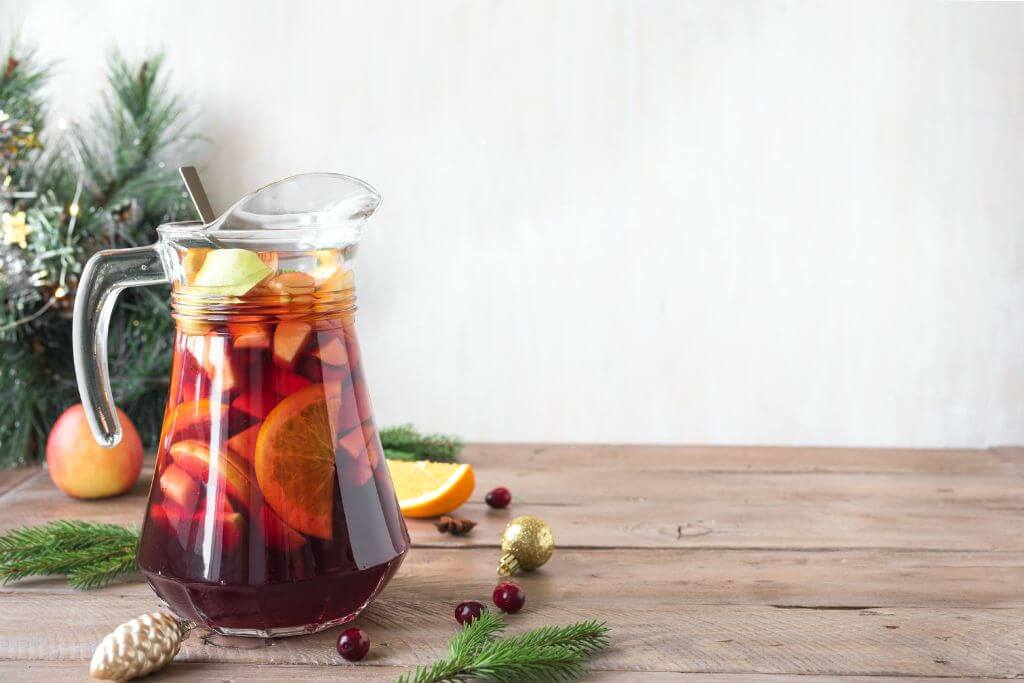
6. Iberian Ham
Iberian Ham is a traditional Spanish cured ham that is known all over the world.
It is one of the unique foods from Spain that is hard to find elsewhere.
Iberian ham comes on a plate as thinly sliced pieces. It is one of the most expensive tapas.
You can see it hanging on the walls of almost every restaurant and bar.
Before buying any to take home, check online if you are allowed to as some countries do not allow the import of it.
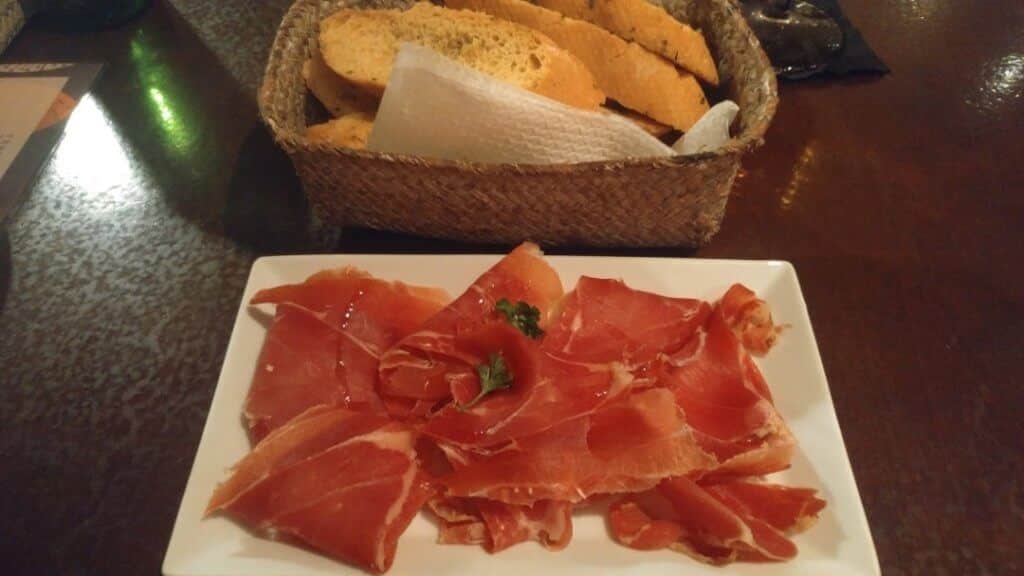
What is special about the Iberian ham?
Iberian ham, also known as Jamón Ibérico, is special because it comes from a specific breed of pig, the Iberian pig, which is raised and fed in a specific way in Spain and Portugal.
The pigs are allowed to roam free and eat acorns, which gives the meat a distinctive flavor and texture.
Also, the curing process is unique and can take up to three years, resulting in a highly prized and expensive delicacy.
Why is Iberian ham so expensive?
Iberian ham is expensive for several reasons.
Firstly, it comes from a specific breed of pig, the Iberian pig, which is raised in a specific way and fed a diet of acorns.
Secondly, the curing process is time-consuming, with the ham often taking up to three years to cure.
Finally, the production of Iberian ham is limited, as it is only produced in certain regions of Spain and Portugal, and is subject to strict regulations.
All of these factors contribute to the high price of Iberian ham, making it a luxury item that is highly prized by food connoisseurs.
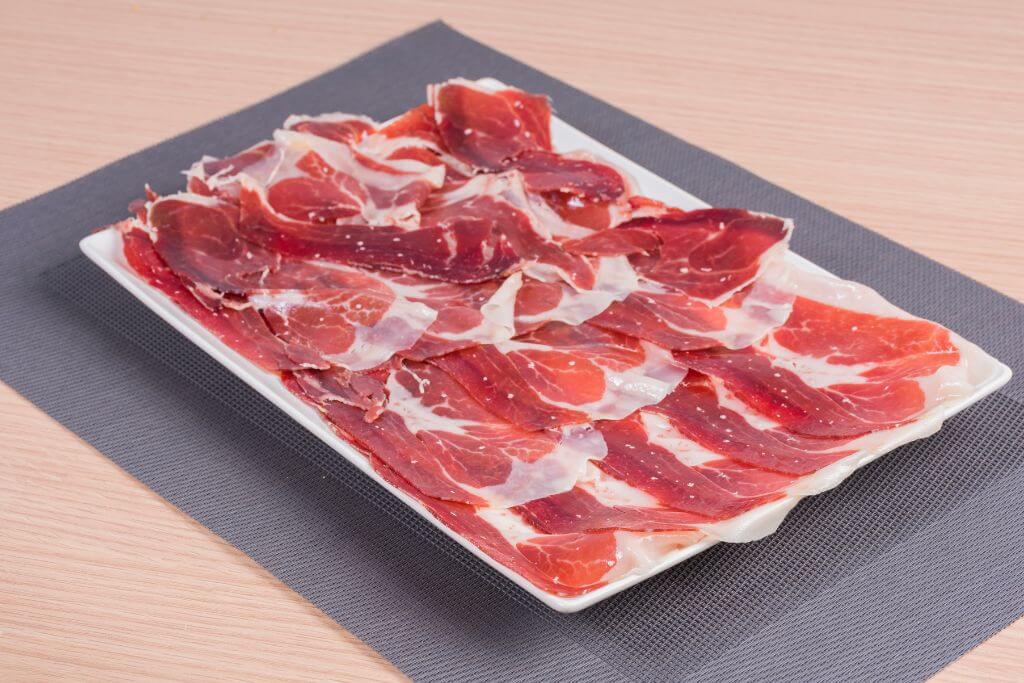
Is Iberian ham the same as prosciutto?
Iberian ham and prosciutto are similar in that they are both cured hams, but they come from different regions, curing processes, and are made from different types of pigs.
The Iberian pig is known for its ability to store fat in its muscles, which gives the meat a distinctive flavor and texture.
Prosciutto, on the other hand, comes from Italy and is made from a Large White or Landrace breed of pigs.
So, while they are both delicious cured hams, Iberian ham, and prosciutto are not the same thing.
How do you eat Iberico ham?
Iberico ham is typically served as a standalone dish or as part of a tapas selection.
It is often served at room temperature and cut into super thin slices using a sharp knife.
Additionally, it is served with bread or crackers to help balance the intense flavor of the meat.
Some people like to drizzle a little bit of olive oil over the ham to enhance the flavor.
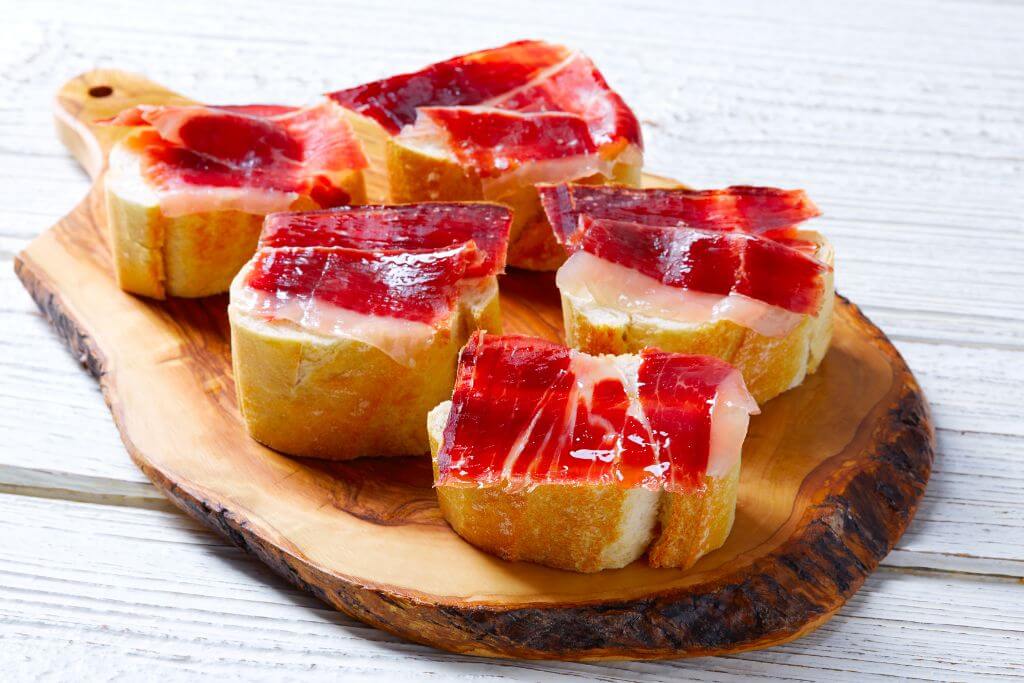
Does Iberico ham need to be cooked?
No, Iberico ham does not need to be cooked. It is a type of cured ham that is typically served uncooked and sliced thinly.
What do you eat Iberico ham with?
Iberico ham is a versatile and flavorful ingredient that can be enjoyed in many ways.
It can be enjoyed on its own or served on a slice of bread such as a baguette.
Also, it can be added to pasta dishes like carbonara or linguine with clams to add depth of flavor and texture.
Additionally, Iberico ham can be used in sandwiches as a delicious and savory filling. It pairs well with a variety of cheeses, vegetables, and condiments.
Overall, the rich and complex flavor of Iberico ham makes it a delicious addition to many dishes, and it can be enjoyed in a variety of ways.
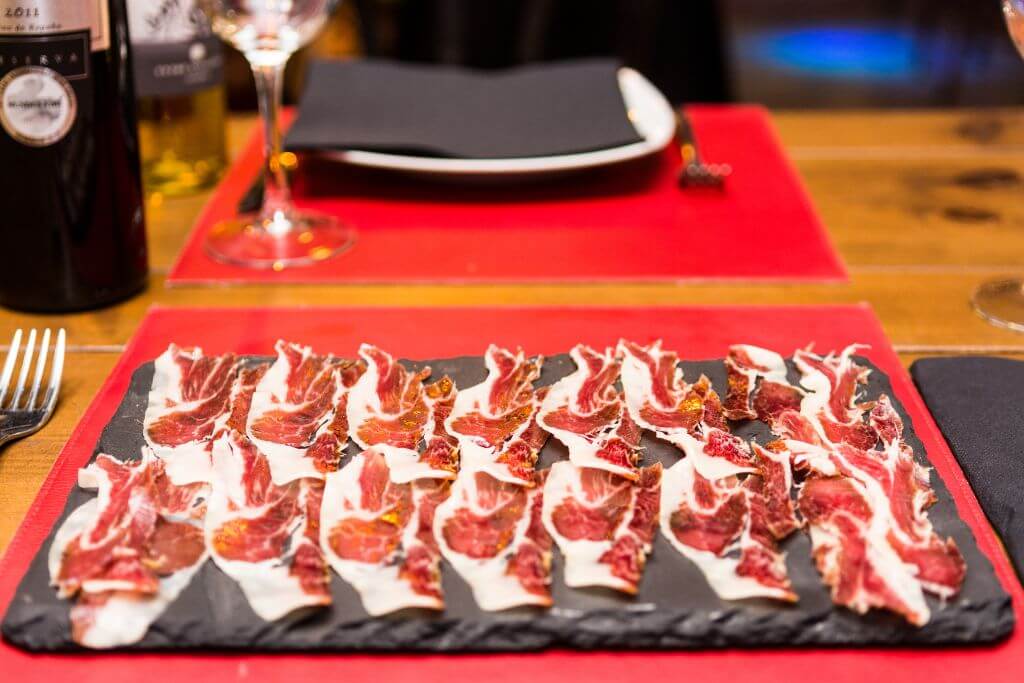
7. Patatas Bravas
Patatas Bravas are square-shaped fries with some sort of dressing usually a spicy one.
Some come with tomato sauce, mayo, aioli, or a different type of sauce. It depends on how the restaurant makes them.
They are one of the most popular tapas and are one of Spain’s traditional foods.
If you are not brave with new foods, this one is a safe choice.
Patatas Bravas were soo delicious and are one of the foods & drinks to try in Spain!!!
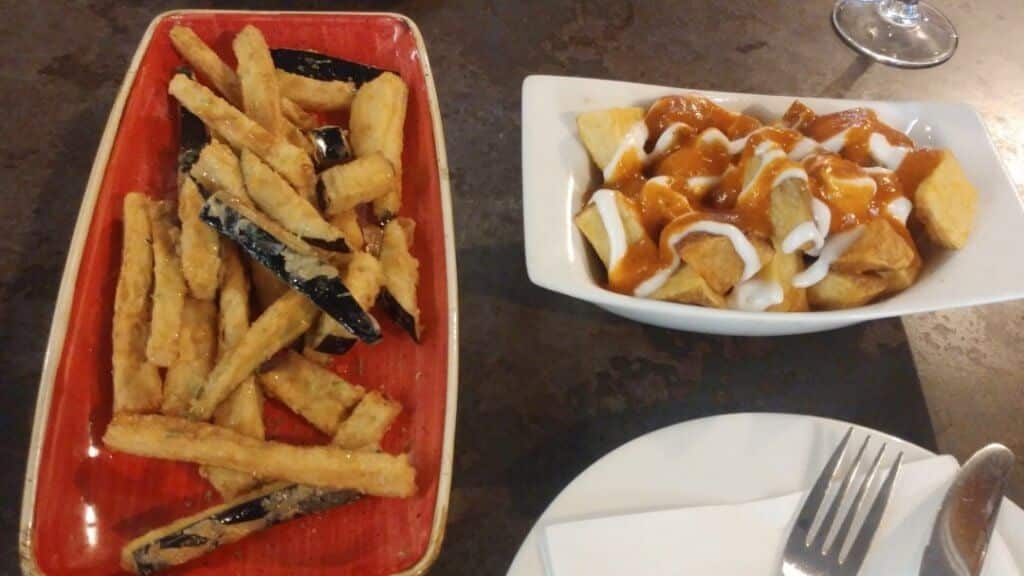
What is patatas bravas in English?
Patatas bravas is a Spanish dish of crispy potatoes served with a spicy tomato-based sauce.
The dish is a popular tapas and can also be served as a side dish or snack.
The potatoes are typically cut into small cubes or wedges and fried until crispy on the outside and tender on the inside.
They are then served with a sauce known as salsa brava, which is a tomato-based sauce that is usually flavored with garlic and paprika.
The sauce can be different levels of spicy, depending on the restaurant.
In addition to the salsa brava, patatas bravas may also be served with aioli (garlic mayonnaise) or other sauces.
The dish is often garnished with parsley or other fresh herbs.
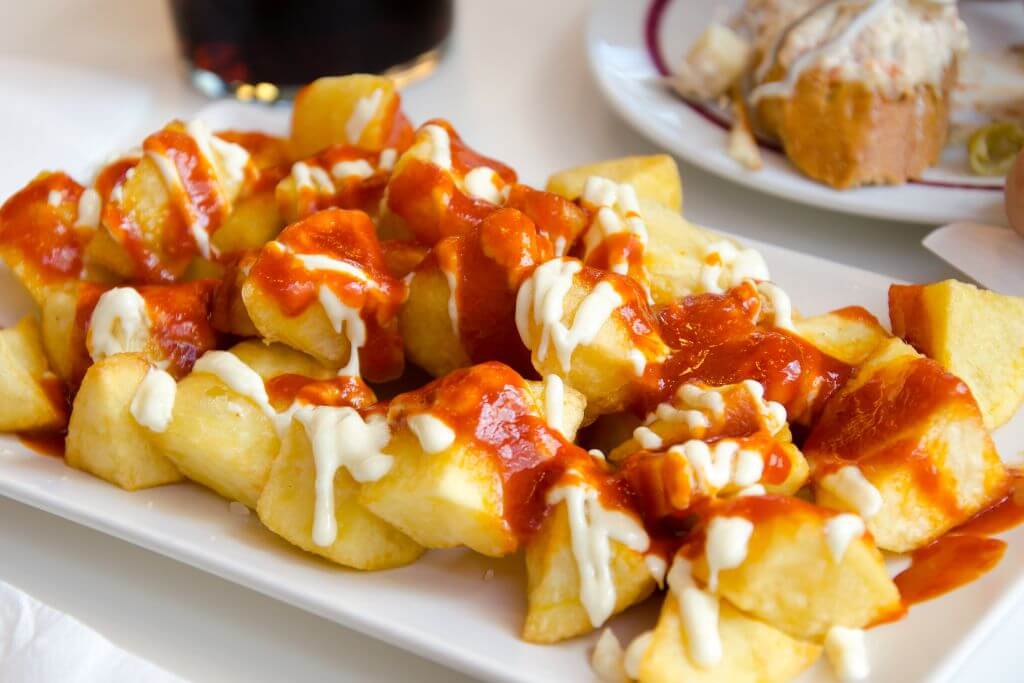
Why is it called patatas bravas?
The name “patatas bravas” translates to “brave potatoes” in English.
There are a few different theories about how the dish got its name, but the most commonly accepted one is that it comes from the bold and spicy flavors of the dish.
Also, the sauce can be quite spicy, which may have contributed to the “brave” title.
What does patatas bravas go with?
Patata Bravas is usually served as tapas. It can be enjoyed on its own or as part of a larger meal.
Also, it can be enjoyed with other sauces (besides salsa brava) such as aioli (garlic mayonnaise), romesco sauce (a nut and red pepper sauce), or a spicy aioli.
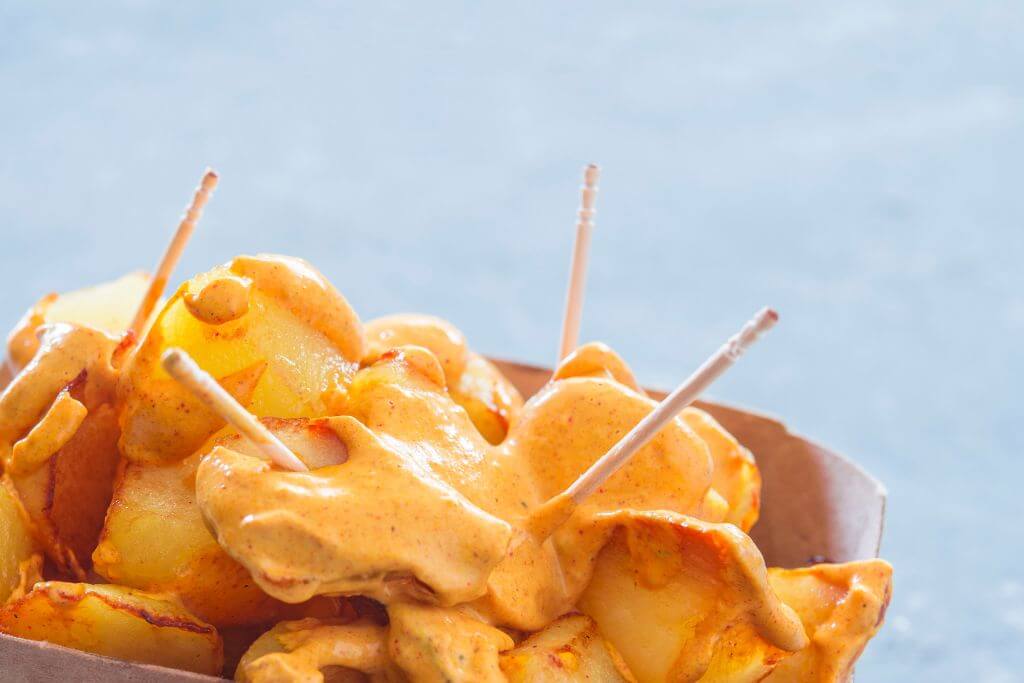
What to serve with patatas bravas?
Patatas bravas can be served alongside grilled meats, such as chicken, beef, or pork.
The crispy and flavorful potatoes provide a nice contrast to the smoky, charred flavors of the meat.
Also, it pairs well with seafood dishes like shrimp, calamari, or octopus.
Additionally, a fresh, crisp salad is a great accompaniment to patatas bravas.
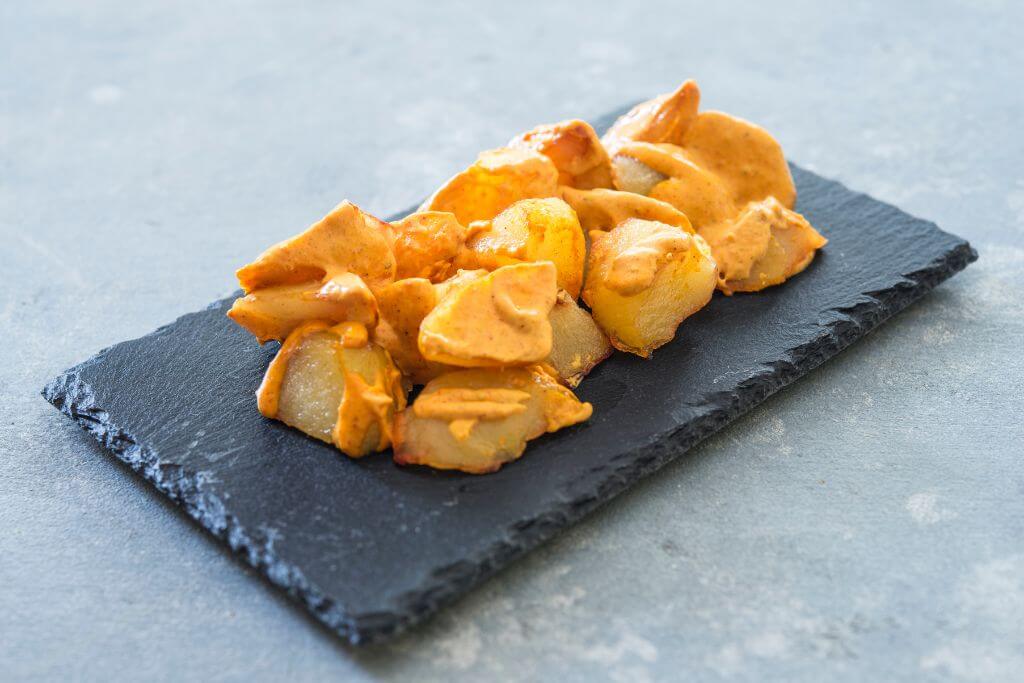
🦄 Related Spain Posts:
5 Best Barcelona Ghost Tours To Take
13 Best Gaudi Barcelona Tours To Take
22 Best Things To Do In Barcelona In October
8. Seafood – Anchovies, Calamari, Fish
As Spain is located on the Mediterranean Sea, they have a lot of seafood dishes.
Most of them include small, salty fish like anchovies and sardines.
Also, calamari and squid are popular and can be prepared in many different ways.
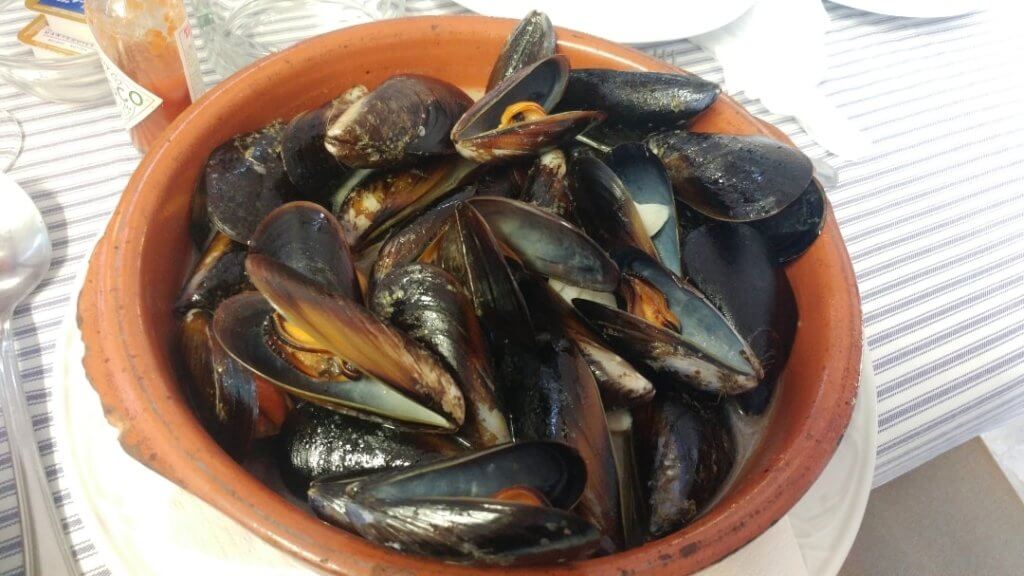
Also, we tried local mussels and oysters and they were delicious.
You can order tapas seafood (simply to taste them) or a full meal such as seafood paella.
Therefore, if you like seafood this is the place to try a ton.
What seafood is popular in Spain?
Seafood is popular in Spain due to the country’s extensive coastline and rich marine biodiversity. Some of the most popular seafood dishes in Spain include:
Paella de Marisco: a seafood paella that typically includes shrimp, clams, mussels, and squid.
Pulpo a la Gallega: a Galician-style octopus dish that is usually boiled and seasoned with paprika, olive oil, and sea salt.
Gambas al Ajillo: garlic shrimp that are cooked in olive oil with garlic and chili flakes.
Chipirones: small squid that is typically grilled or fried and served with a variety of sauces.
Langostinos: large prawns that are usually grilled or boiled and served with garlic, olive oil, and lemon.
Mejillones en Escabeche: mussels that are pickled in vinegar and herb sauce.
Sardinas: fresh sardines that are usually grilled and served with a squeeze of lemon.
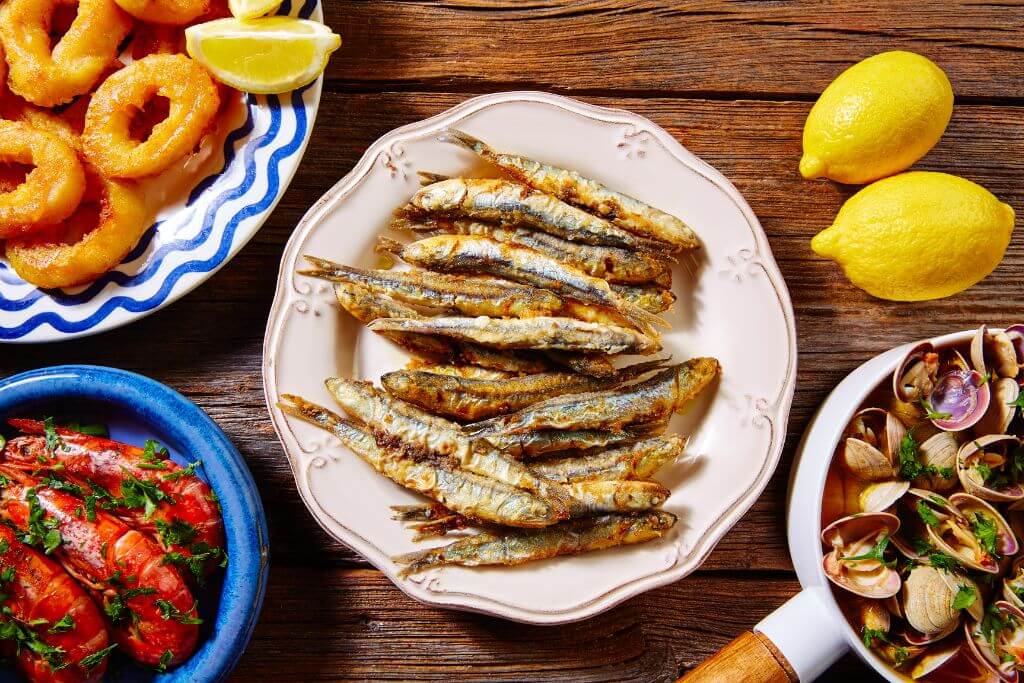
Are anchovies popular in Spain?
Yes, anchovies are quite popular in Spain and are a common ingredient in many Spanish dishes.
In fact, Spain is one of the largest producers of anchovies in the world.
Anchovies are part of a variety of Spanish dishes, including tapas, salads, and main dishes.
What are anchovies called in Spain?
In Spain, anchovies are called “anchoas”. The word “anchoa” refers to both fresh and cured anchovies.
Fresh anchovies are typically found in coastal areas and are often served grilled or fried.
Cured anchovies, on the other hand, are more widely available and are commonly used in Spanish cuisine.
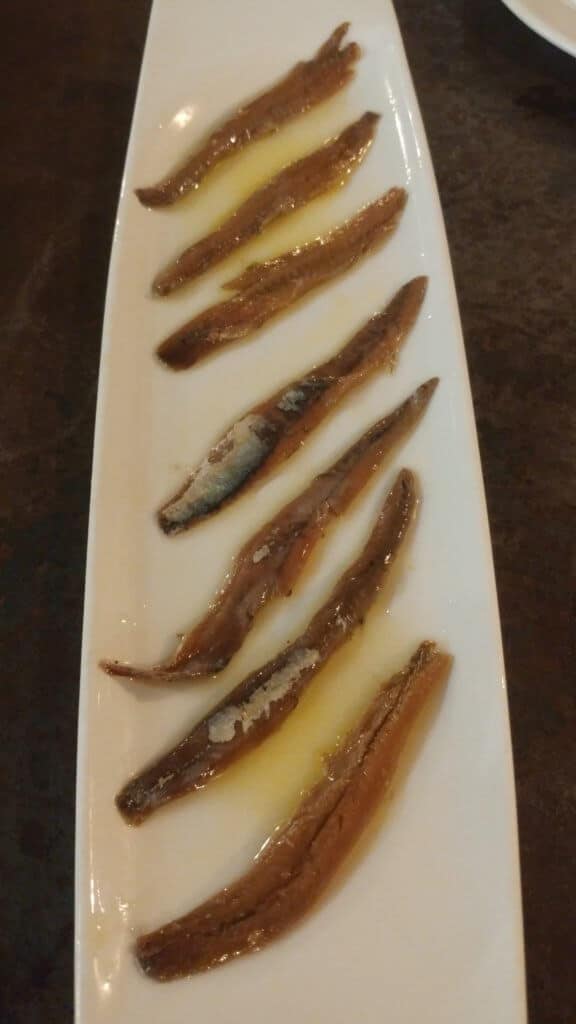
Is calamari popular in Spain?
Yes, calamari is a popular dish in Spain, especially in coastal areas where fresh seafood is abundant.
Calamari can be prepared in various ways, such as deep-fried, grilled, or in a stew, and it is often served as a tapa or as a main course.
In fact, deep-fried calamari rings are a staple in Spanish cuisine and are commonly part of the menus of bars and restaurants throughout the country.
What is a popular fish dish in Spain?
One of the most well-known fish dishes in Spain is probably bacalao al pil pil, which is made with salt cod that is slowly cooked in olive oil and garlic until it becomes tender and flaky.
Another popular fish dish is merluza en salsa verde, which features hake fillets cooked in a sauce made with parsley, garlic, and white wine.
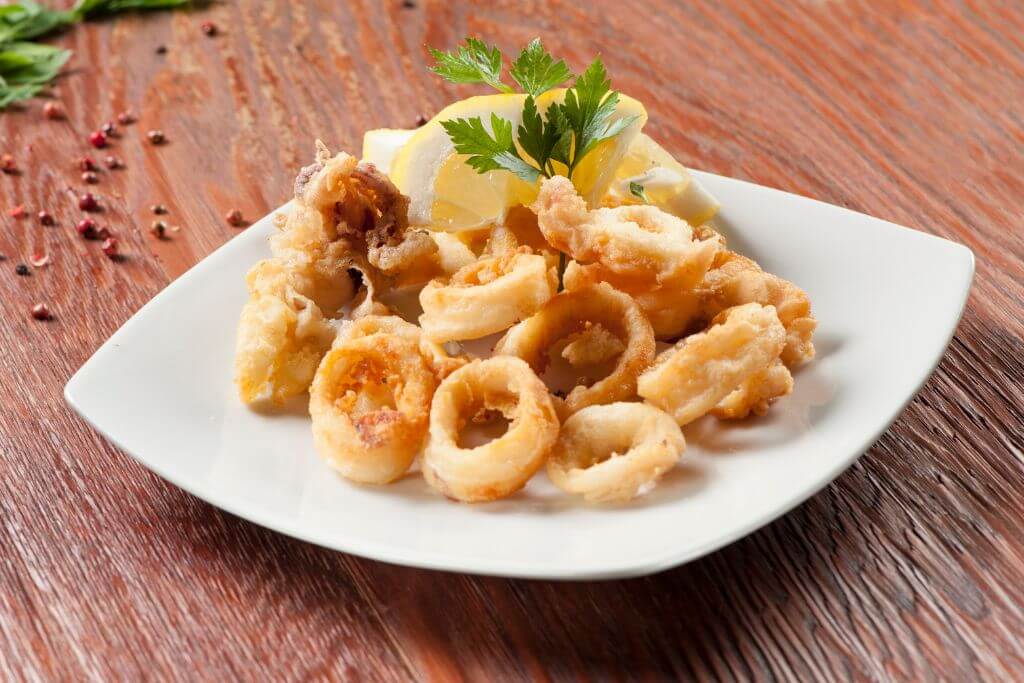
What is the traditional fish in Spain?
Some of the most commonly consumed traditional fish in Spain include the following:
Bacalao (salt cod): Although not a native fish to Spain, bacalao has been an important part of the country’s cuisine for centuries.
Merluza (hake): Hake is a white fish that is widely consumed throughout Spain, particularly in the northern regions.
Lubina (sea bass): Sea bass is a popular fish that is often grilled or baked and served with a variety of sauces.
Boquerón (anchovy): Fresh anchovies are a popular tapa throughout Spain, particularly in coastal regions.
Sardinas (sardines): Sardines are a staple of summer barbecues and can be found at many beachside restaurants and chiringuitos (beach bars).
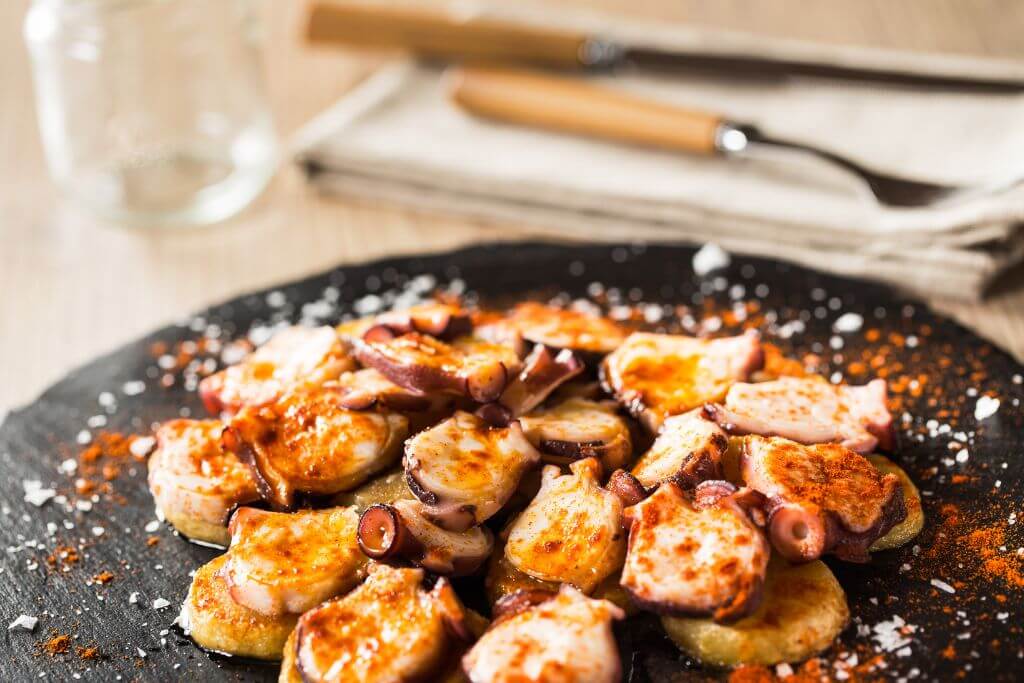
9. Pintxo
Also known as pincho or pinchu, is a small snack that people usually order in bars or Pintxo Restaurants.
They are essentially a slice of bread that has some tasty topping on top and has a stick going through the middle to keep the food from falling off.
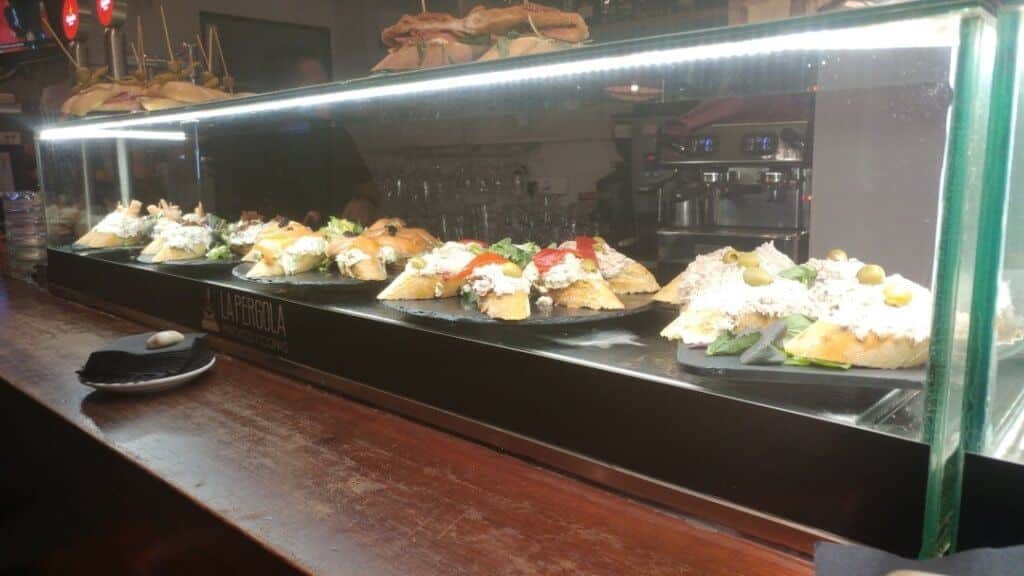
The name comes from the Spanish verb “Pinchar” which means to pierce (with the stick).
Those bad boys are soo yummy and rich in flavor and there is such a big variety.
Some of the toppings include traditional items like local cheese, olives, meats, fish, etc.
Here is a link to the La Pergola restaurant, which is located in Palma de Mallorca if you want to try Pintxos.
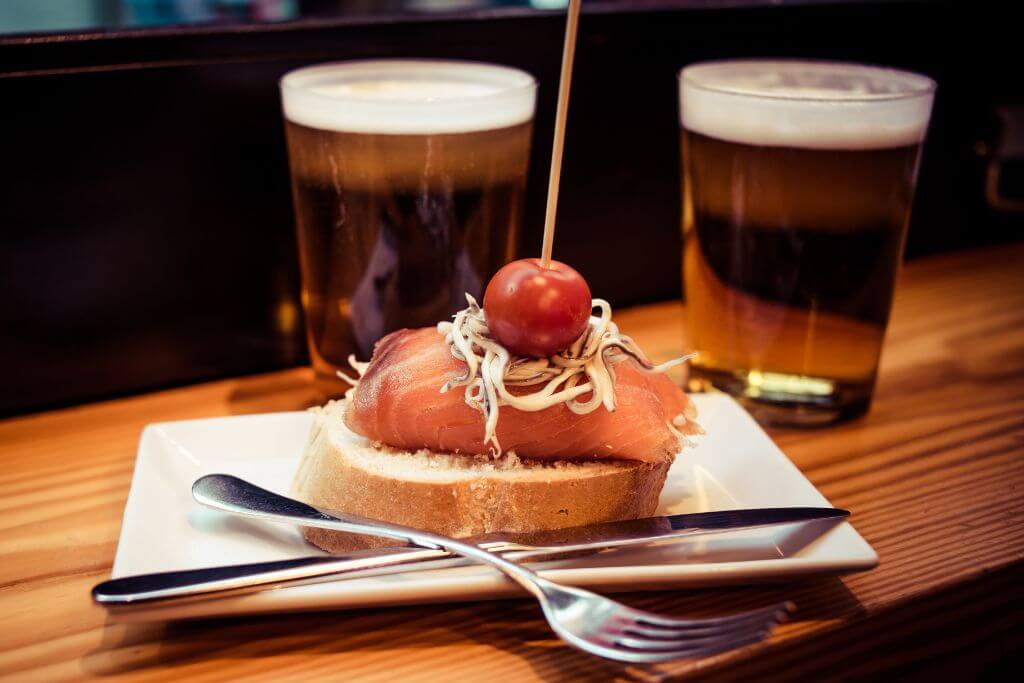
What is a pintxo in Spanish?
A pintxo is a small snack or appetizer that is typically eaten in Spain.
Pintxos are often served on a small slice of bread or on a toothpick, and they can be made with a variety of ingredients, such as seafood, cured meats, vegetables, and cheeses.
They are usually displayed on a counter or bar area, and customers can select the ones they want to eat.
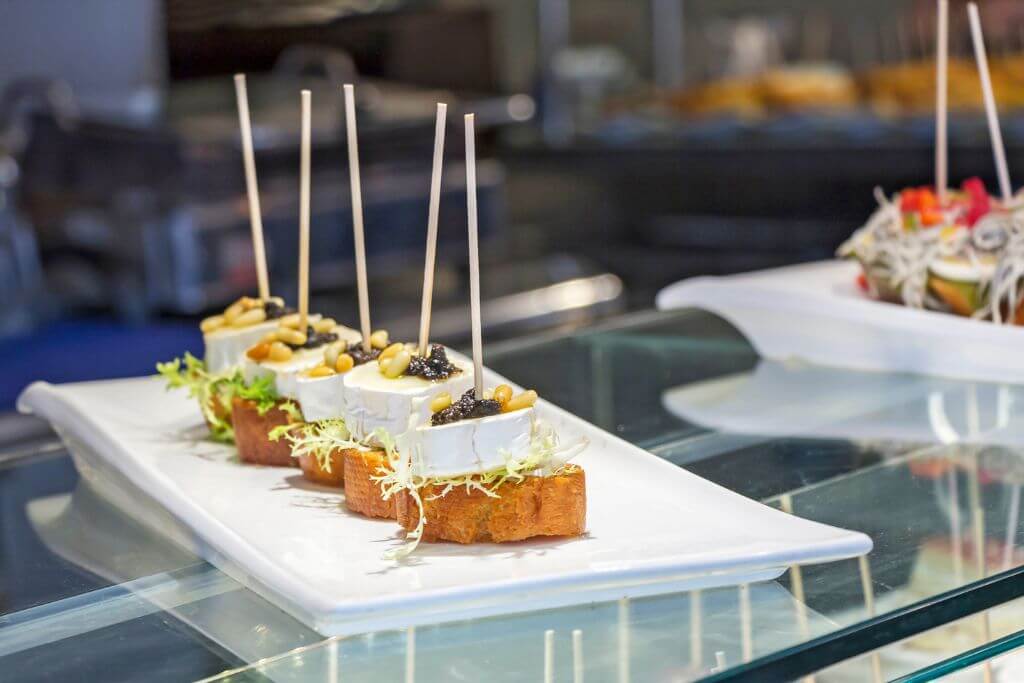
What is the difference between tapas and pintxos?
Both tapas and pintxos are small dishes that you will find in bars and restaurants in Spain.
However, tapas are typically shared plates and are associated with the southern region of Spain.
While pintxos are individual snacks on a toothpick or skewer and are from the northern Basque region.
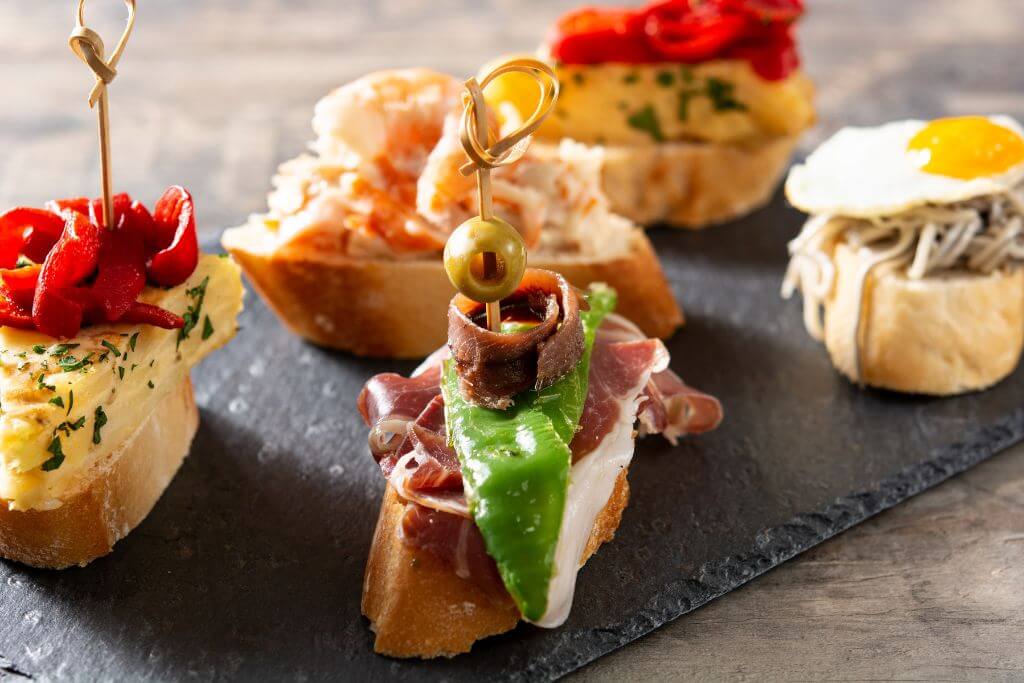
How many pintxos per person?
In a social setting, it’s common to order multiple pintxos to share with a group of people, and it’s typical for each person to have 2-3 pintxos each.
If you’re ordering pintxos for a meal, you may want to order more than that.
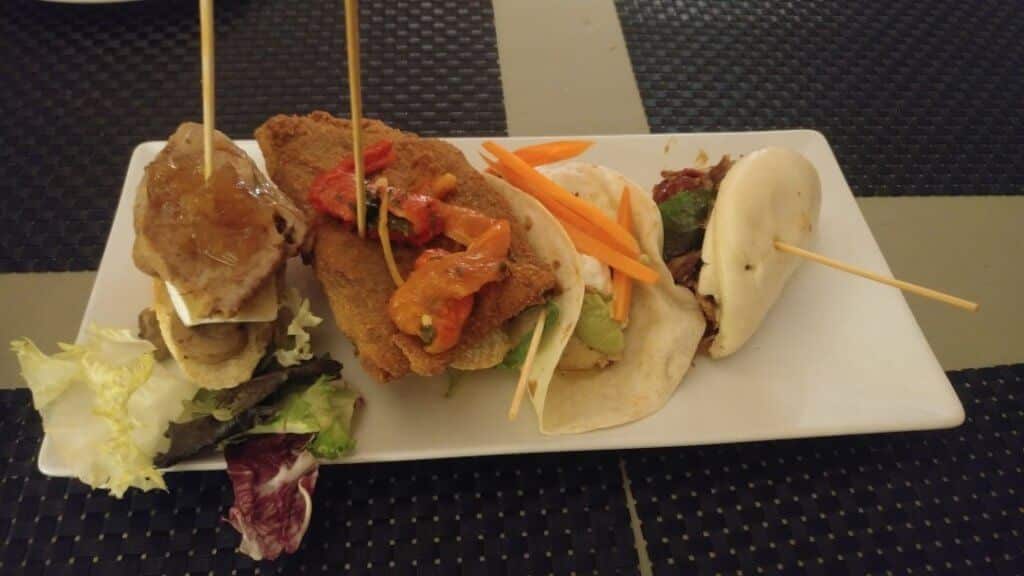
🦄 Related Spain Posts:
Tips For Visiting Sagrada Familia For The First Time
Barcelona: Gothic Quarter, La Rambla & Flamenco Show
Barcelona: Casa Batllo, Casa Mila & Casa Vicens
All You Need To Know About Park Guell, Barcelona
10. Crema Catalana
Crema Catalana is a popular Catalan sweet that looks similar to a Creme Brulee.
I do find the Crema Catalana to be a bit lighter than the Creme Brulee.
It is essentially a custard dessert with a crispy crust on the top (and I cannot say no to that).
I saw it as a dessert option in a few places so it should not be hard to find.
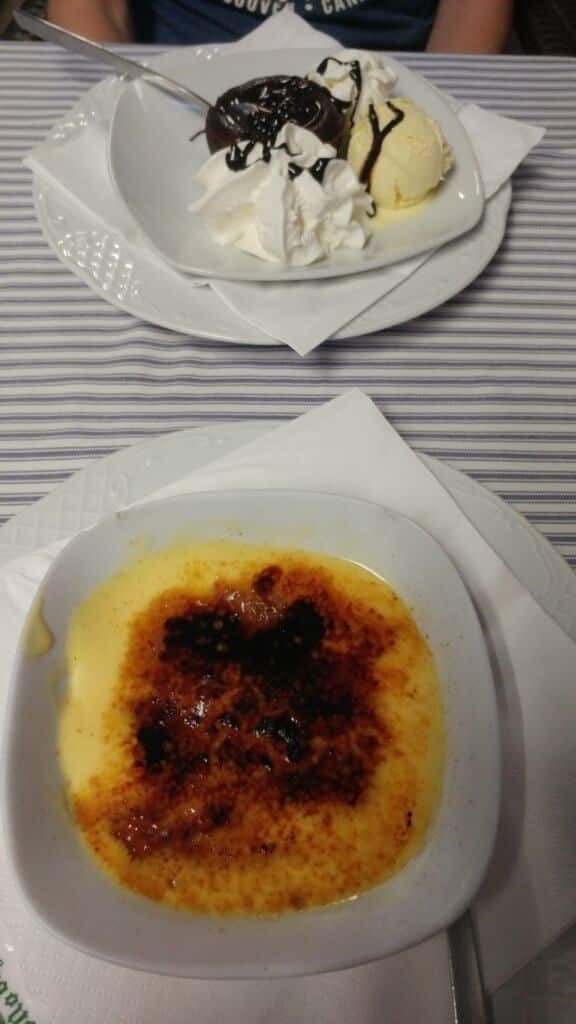
What is the difference between Crème Brûlée and Crema Catalana?
Although the two desserts are quite similar in many ways, there are a few key differences between them.
Crème Brûlée is a French dessert that has been around since the 17th century, while Crema Catalana is a traditional dessert from Catalonia, Spain.
Also, Crème Brûlée is made with a custard base that is made with heavy cream, egg yolks, sugar, and vanilla.
Crema Catalana, on the other hand, is typically made with milk, egg yolks, sugar, and cornstarch or flour to thicken the mixture.
Additionally, Crème Brûlée has a rich, creamy flavor that is often enhanced with vanilla or other flavorings.
While Crema Catalana is flavored with lemon zest and cinnamon, which gives it a slightly citrusy, spiced flavor.
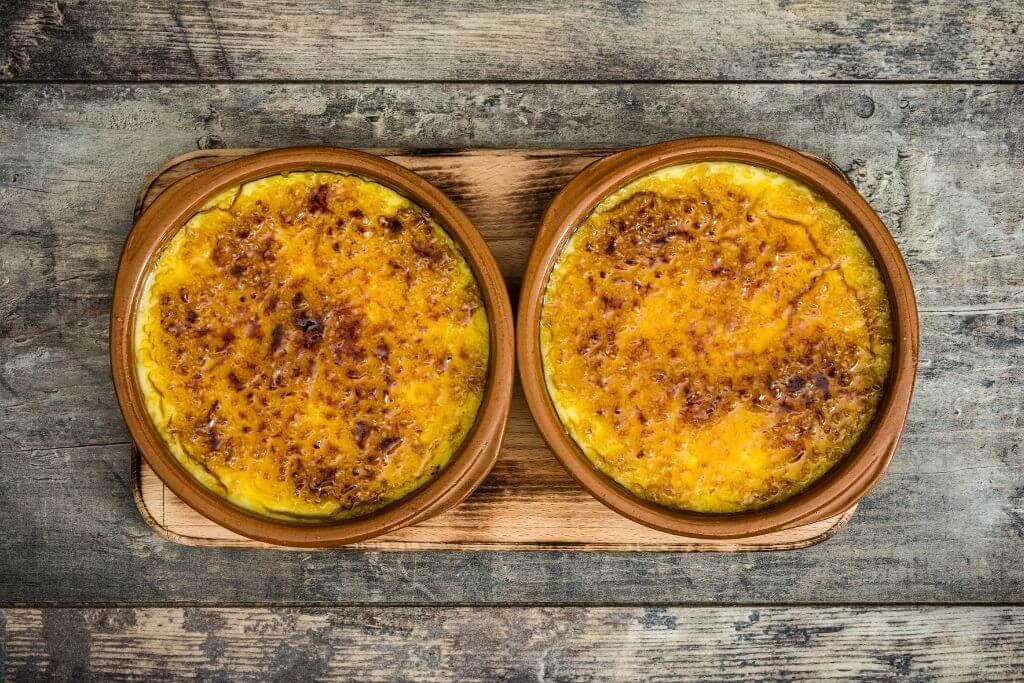
Is crema catalana the same as flan?
Crema Catalana is made with milk, egg yolks, sugar, cornstarch, or flour, and flavored with lemon zest and cinnamon.
The custard is cooked on the stovetop and then chilled until set.
Right before serving, a layer of sugar is sprinkled on top and caramelized with a blowtorch or under a broiler, creating a thin, crispy crust.
Flan, on the other hand, is a dessert that is popular in many Latin American countries.
It is made with a custard base of eggs, milk, and sugar, and is typically flavored with vanilla.
The custard is baked in a water bath in the oven, creating a smooth and creamy texture.
Once cooked and cooled, it is inverted onto a plate so that the caramel sauce that forms at the bottom of the baking dish can run over the flan, adding extra sweetness and flavor.
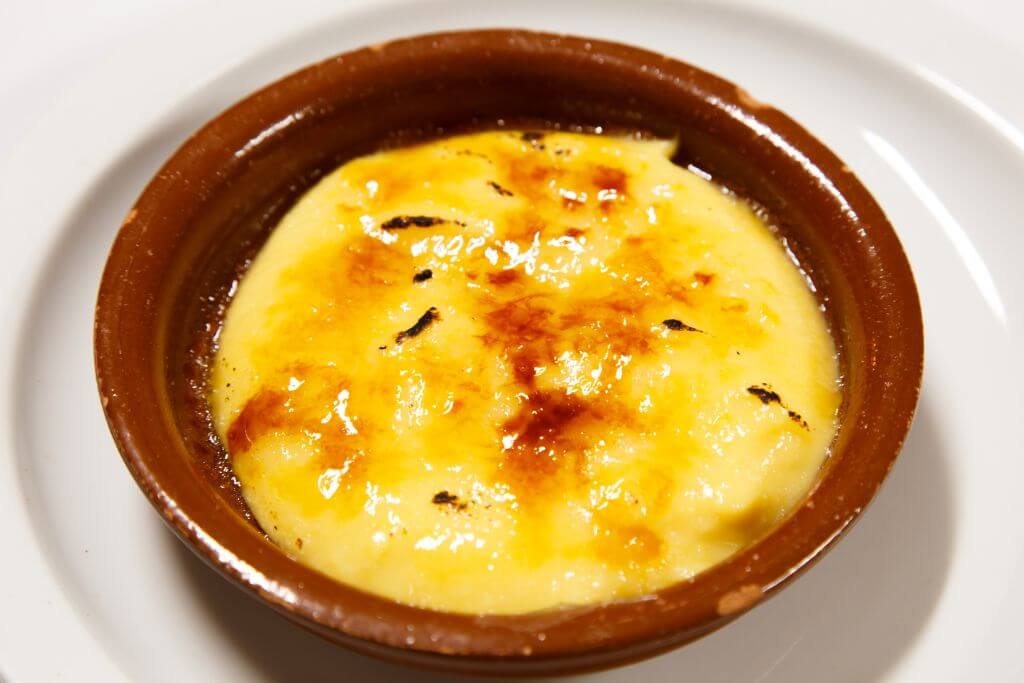
Is crema catalana served warm or cold?
Crema Catalana is a dessert that is typically tastier straight from the refrigerator.
After the custard is cooked on the stovetop and then cooled to room temperature, it is chilled in the refrigerator for at least a few hours to firm up and develop its flavor.
Is there alcohol in crema catalana?
Traditionally, there is no alcohol in Crema Catalana.
However, some modern variations of Crema Catalana may include a small amount of alcohol, such as brandy, rum, or orange liqueur, to add extra flavor.
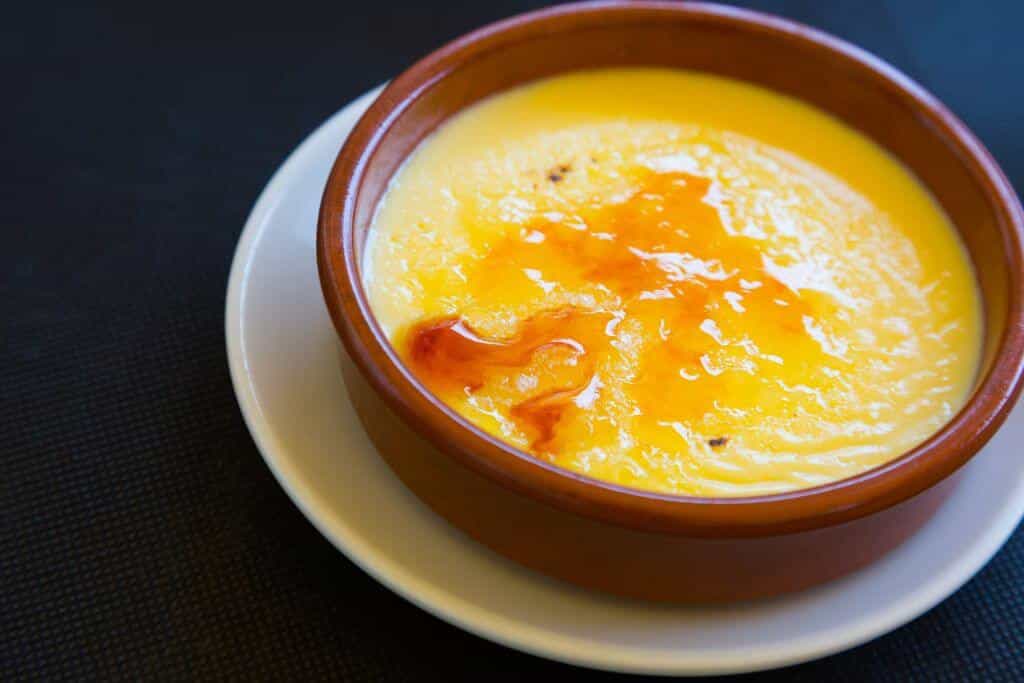
Conclusion: 10 Foods & Drinks To Try In Spain
In conclusion, exploring the diverse foods and drinks in Spain offers a journey through regional culinary traditions.
From the renowned paella to the savory pintxos, Spanish cuisine reflects a variety of flavors.
Markets, tapas bars, and upscale restaurants provide different dining experiences, allowing travelers to appreciate the authenticity of Spanish food culture.
Whether trying patatas bravas, jamón ibérico, or churros, each dish narrates Spain’s history and cultural heritage.
Overall, the foods and drinks to try in Spain provide a satisfying exploration of the nation’s culinary treasures.
